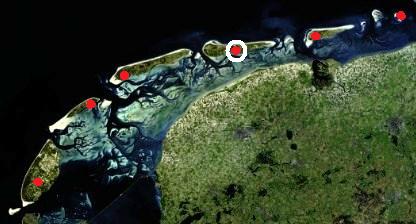
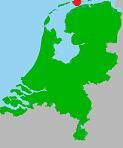
Relation with Lake (class): none. Cemetery without Lake-link.
Total nr. of casualties buried here (TC) end WW2: 136, today 69 (on Nes General)
Lake casualties, initially, end WW2 (LC-I): 0
Unknown today: 21 (end war 23)
of which unknown from Lake (LC-U): 0
of which unknown from North Sea (NS-U): 21
Initial burial site in WW2.
Post war burial site for collection and reburial from other sites: no.
Cemetery with Lake casualties today: no.
AMELAND ISLAND (FORMER) WAR GRAVES
There is no relation Zuyder Sea with Ameland. However, our files on Dunkirk and Jonkerbos enable a (rough) reconstruction of what today is not longer visible on Ameland island: the exhumed war graves at Hollum, Ballum, Nes General and Nes Roman Catholic Cemetery.
Two months after the Dunkirk evacuation, which took place May 26- June 4th 1940, Ameland was confronted with this when a group of 50 dead soldiers washed ashore in a few days time on the Ameland beaches. This was end July/begin August 1940. Among them was German meteorologist Dr. Wille, in service with the Luftwaffe, shot down over the North Sea in a Dornier-17 some weeks before Dunkirk. By coincidence the current mixed-in his body with the Dunkirk dead. He still rests on Ameland in Nes RC.
38 of the washed ashore victims were French-Moroccan and French soldiers & sailors, one of them a woman. Another was Dutch Army Lieutenant van Gorp. He had also tried to escape the Germans via Dunkirk. Nine dead in the group were British. Of one person the nationality could not be established.
The 50 were buried on the four cemeteries on the island: Hollum (16), Ballum (8), Nes Roman Catholic (6) and Nes General (20). Later during WW2 Nes General became the main burial cemetery for the Island. The number of washed ashore airmen grew in Nes to 95.
After the war 64 men were exhumed and moved to centralization war cemeteries on the mainland: first in October 1945 the Americans from Nes General (11), in 1949 the French from all four cemeteries on the island (38 French exhumed), in 1952 the last remaining war graves in Hollum (five British), from Ballum (two British) and from Nes Roman Catholic the Polish (four) and the Commonwealth casualties (four men). This article shows who they were. Their names should not be forgotten.
In recent years we discovered that most of the 50 dead come from one and the same (sunken) ship, escaping Dunkirk.
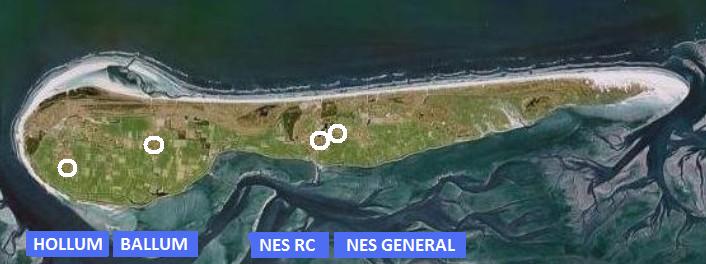
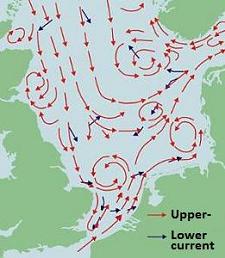
For reaction or comments; send us an email,
see address and info at CONTACT.
Please use as subject title: 'Ameland'.
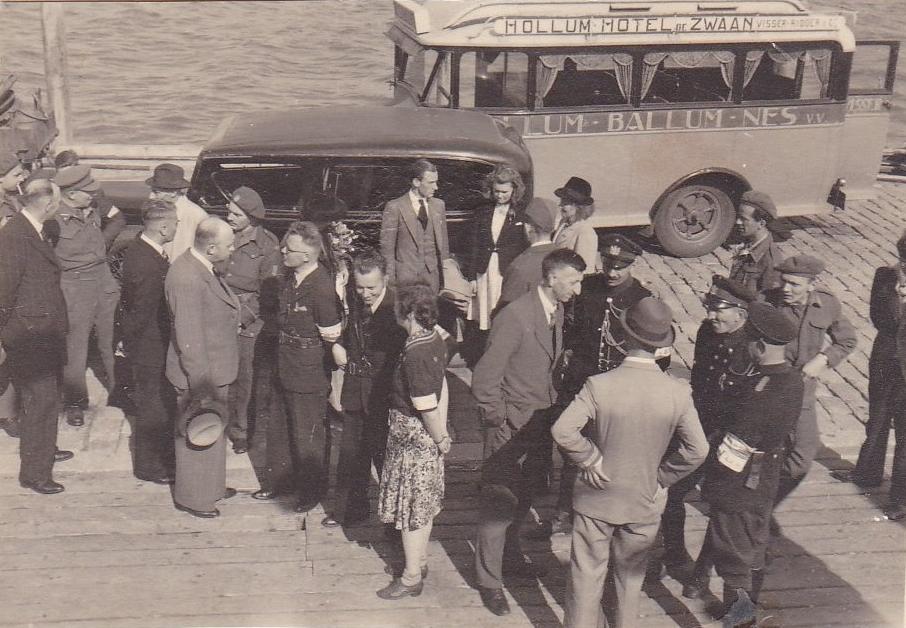
Photo right: 1945, the war has ended. Ameland was liberated late; 3 June 1945. That month an Allied officer is welcomed by the Ameland resistance who had control over the Island after the Germans had left.
The welcome is on the Nes-ferryboat pier (visible on the satellite image above). Dutch officials and policemen wear their N.B.S armbands (indicating member Dutch resistance).
The Allied officer with beret (near steering wheel of the car) is important for our story on this webpage. After his reception he is visiting all four war grave sites on Ameland Island (see photos further below).
We believe he is the famous Canadian General Guy Simonds. He was in North Germany May 1945 and made some stops (Amsterdam) before returning to the UK, but apparently also Ameland. He was fluent in French language and is suprised by the number of French dead on Ameland and shows great interest and respect at their graves.
His adjutant keeps a close eye on him (standing near the back wheel of the bus).
On the left, outside this picture, is a group of resistance men standing ready as escort (see photo further below).
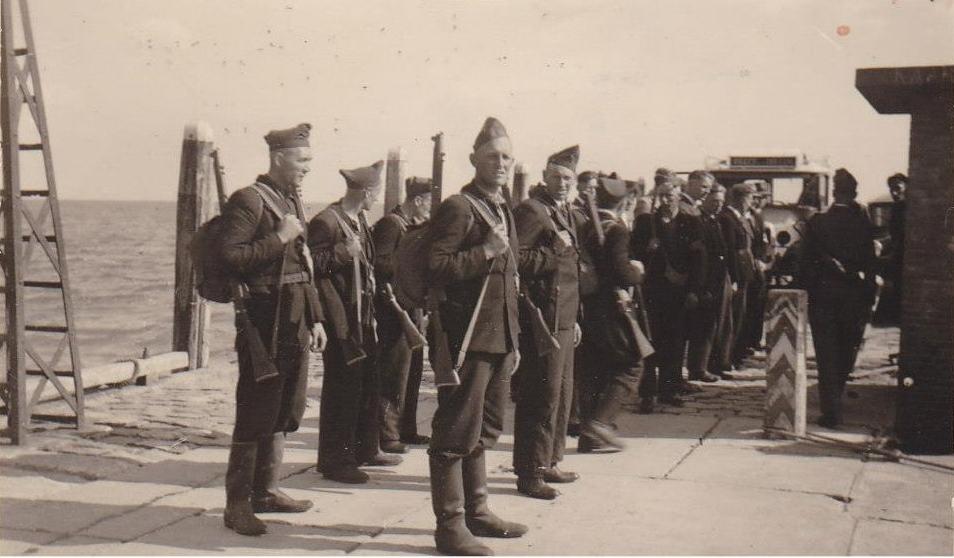
The Dutch resistance escort that welcoms the Allied visitors.
The two men front seem to wear German army boots. All carry a British Lee-Enfield rifle and an US-style cloth bandolier with extra ammunition. The bus is in the backgroud.
The ferry is docked in front of them and moored on the chevroned pole.
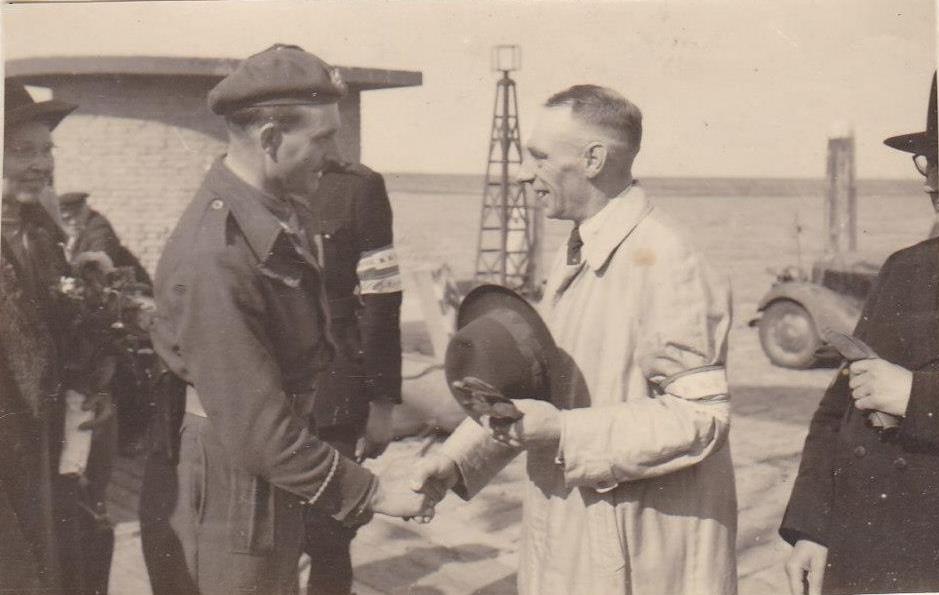
Handshake with the General.
Major-General Guy Simonds.

One of the three important Canadian WW2 generals. Guy Simonds fought in Italy, Normany (Falaise) and up to northwest Germany.
BALLUM
Village tower and Protestant cemetery.
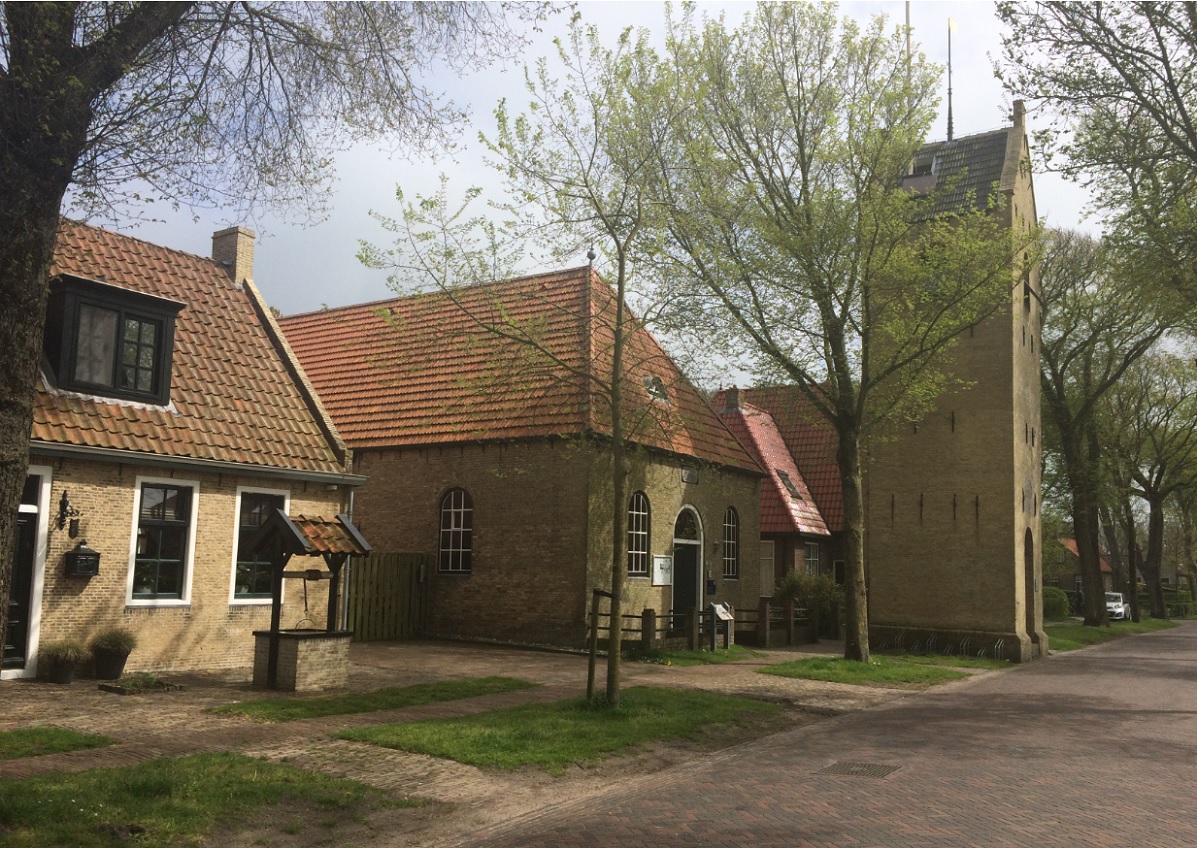
Ballum cemetery.
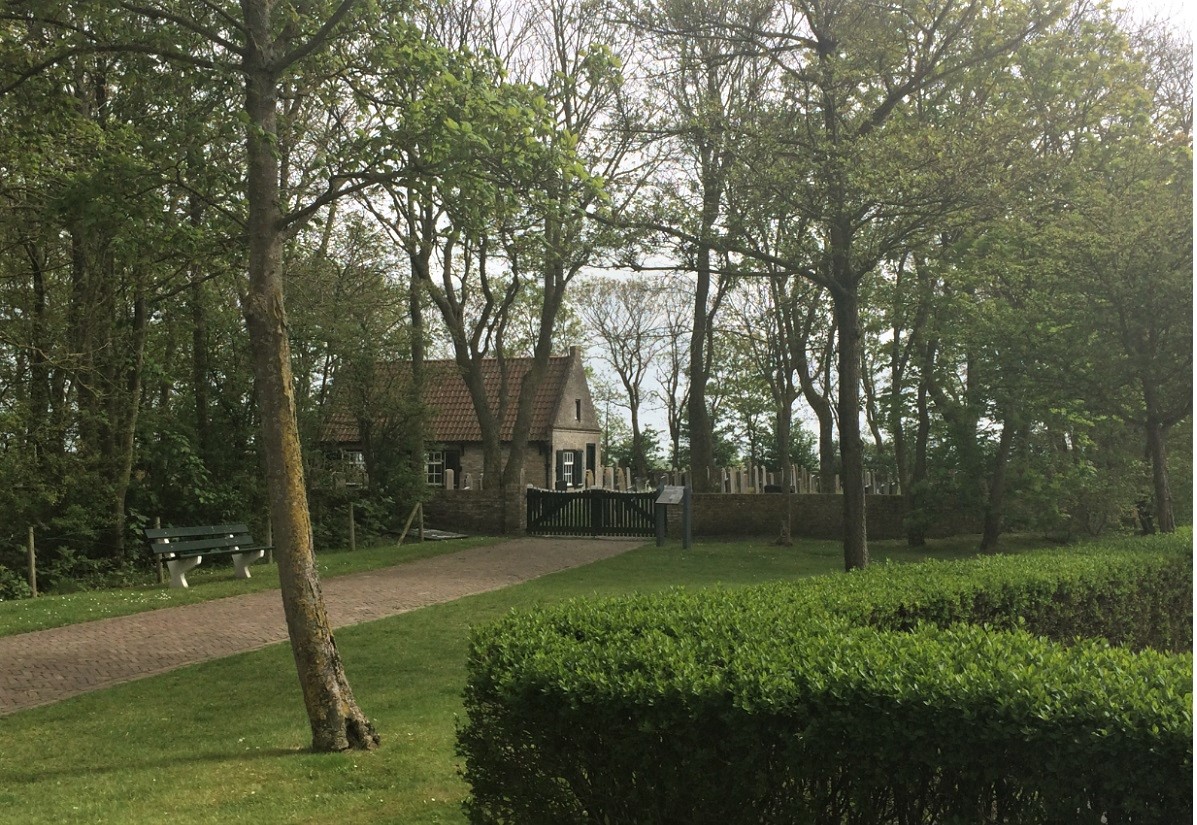
August 15, 1940
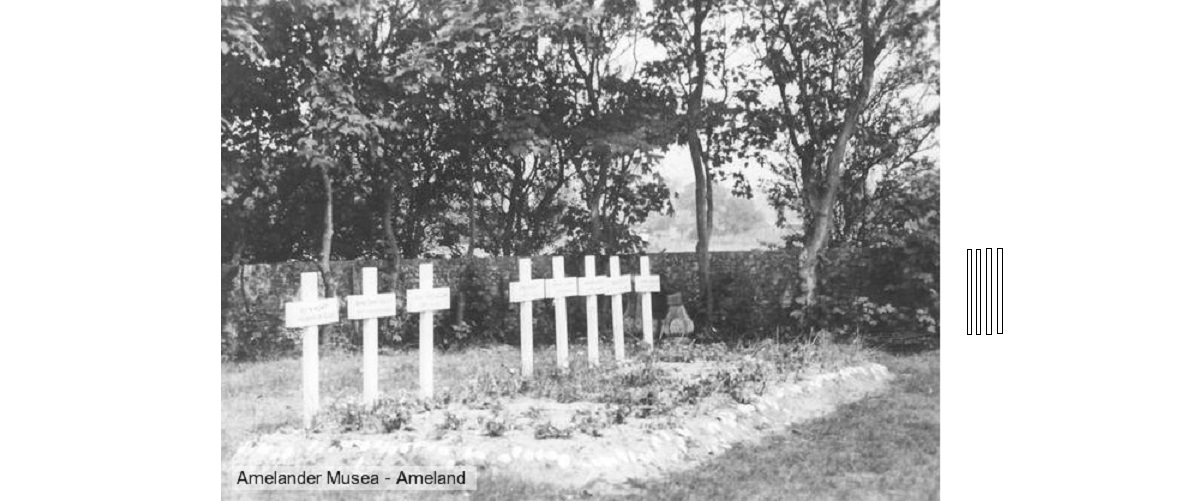
C.
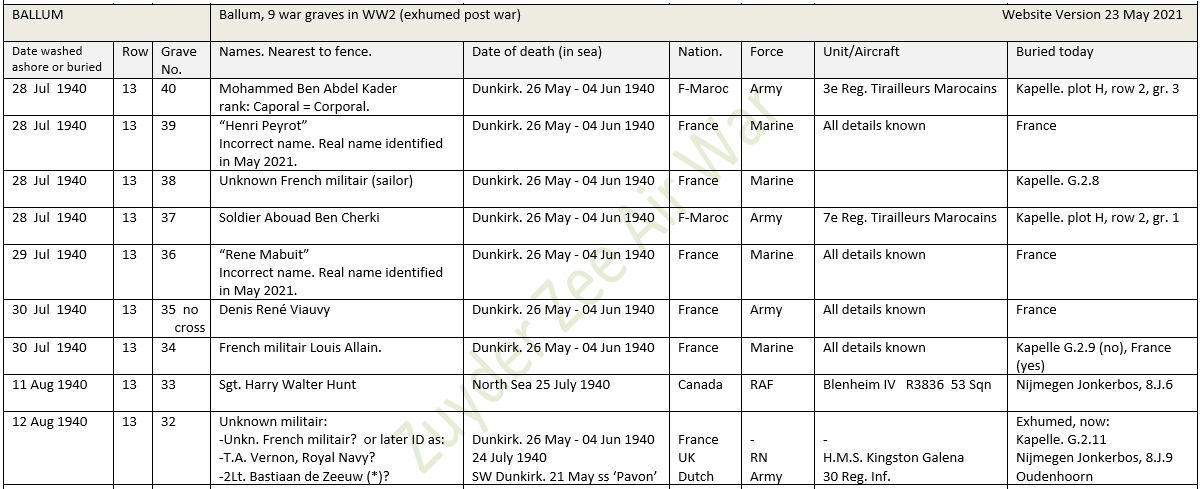
Ca.
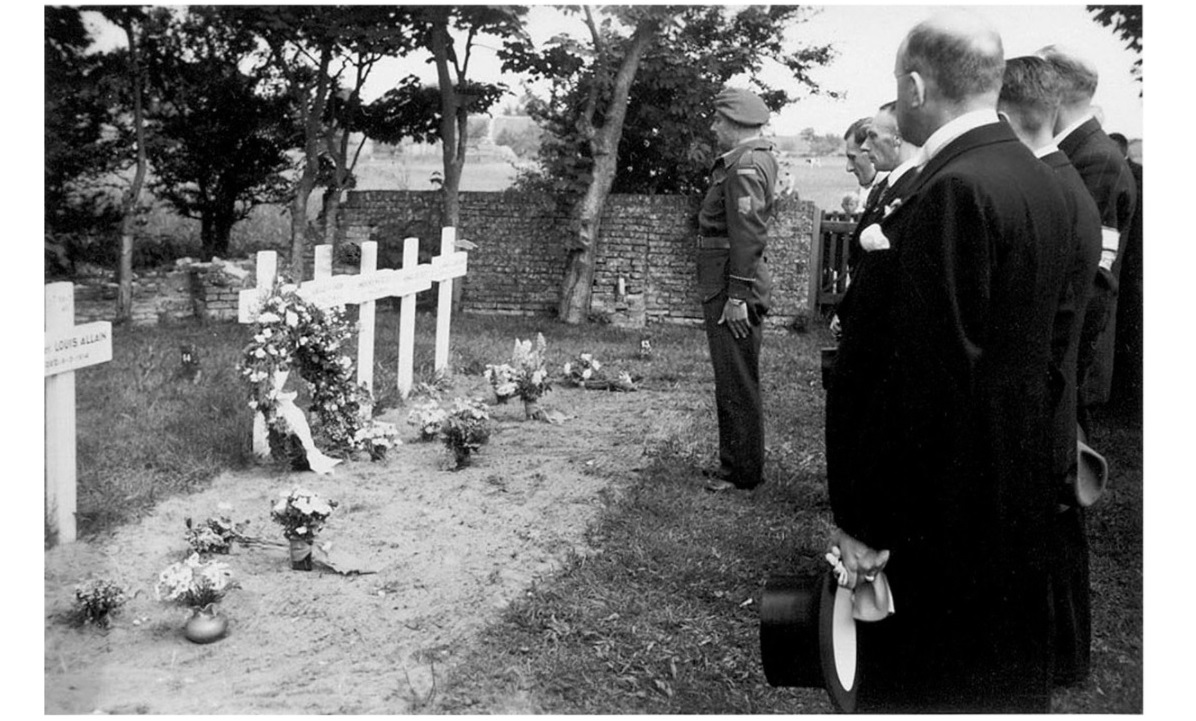
F.
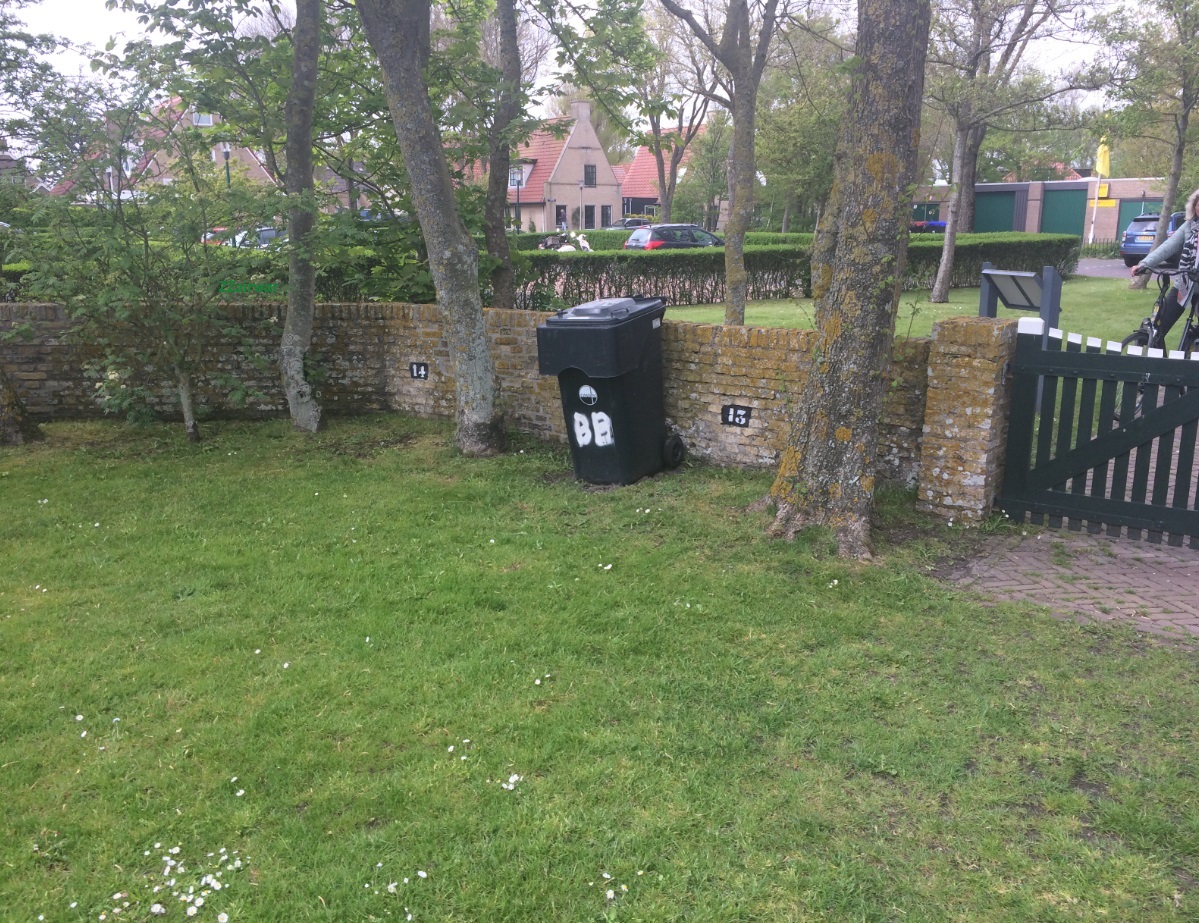
G.
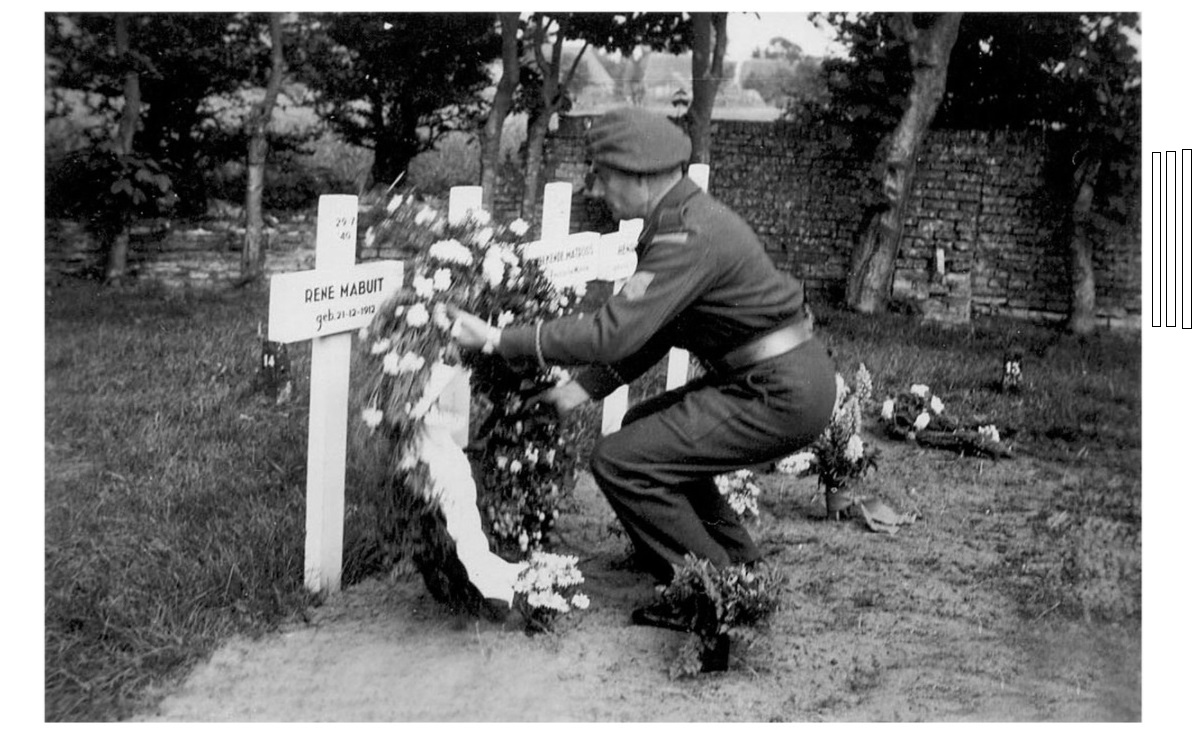
J.
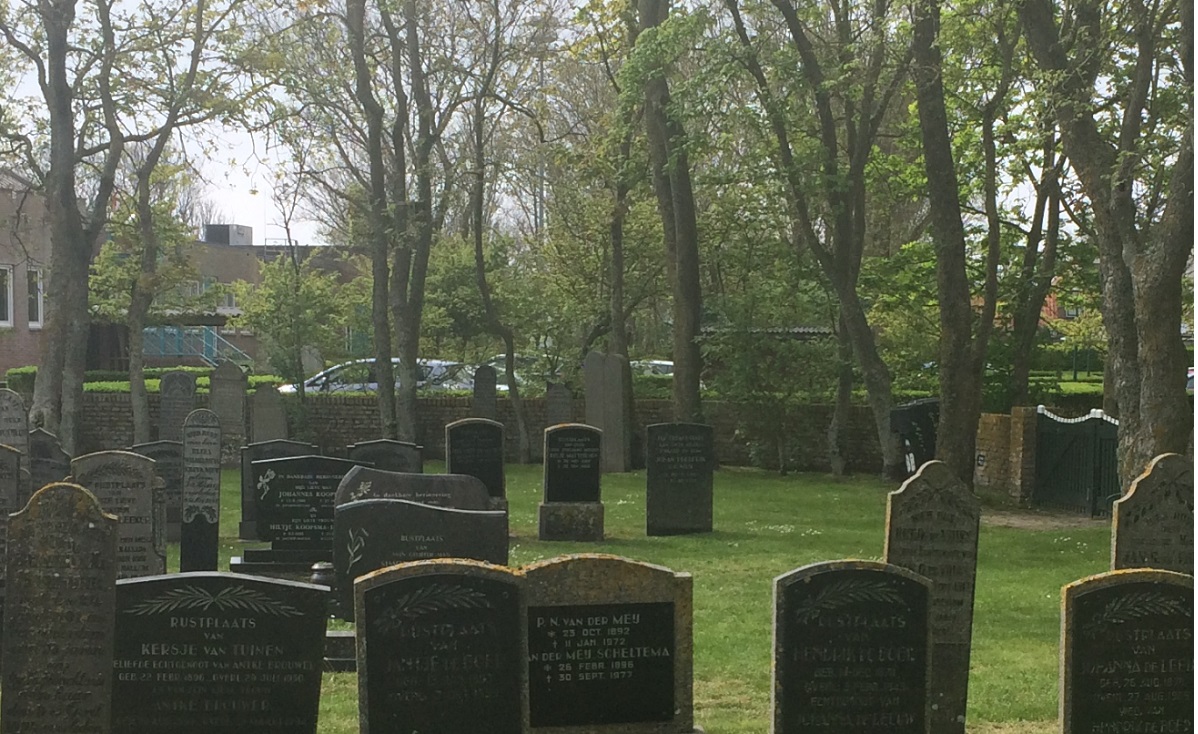
H.
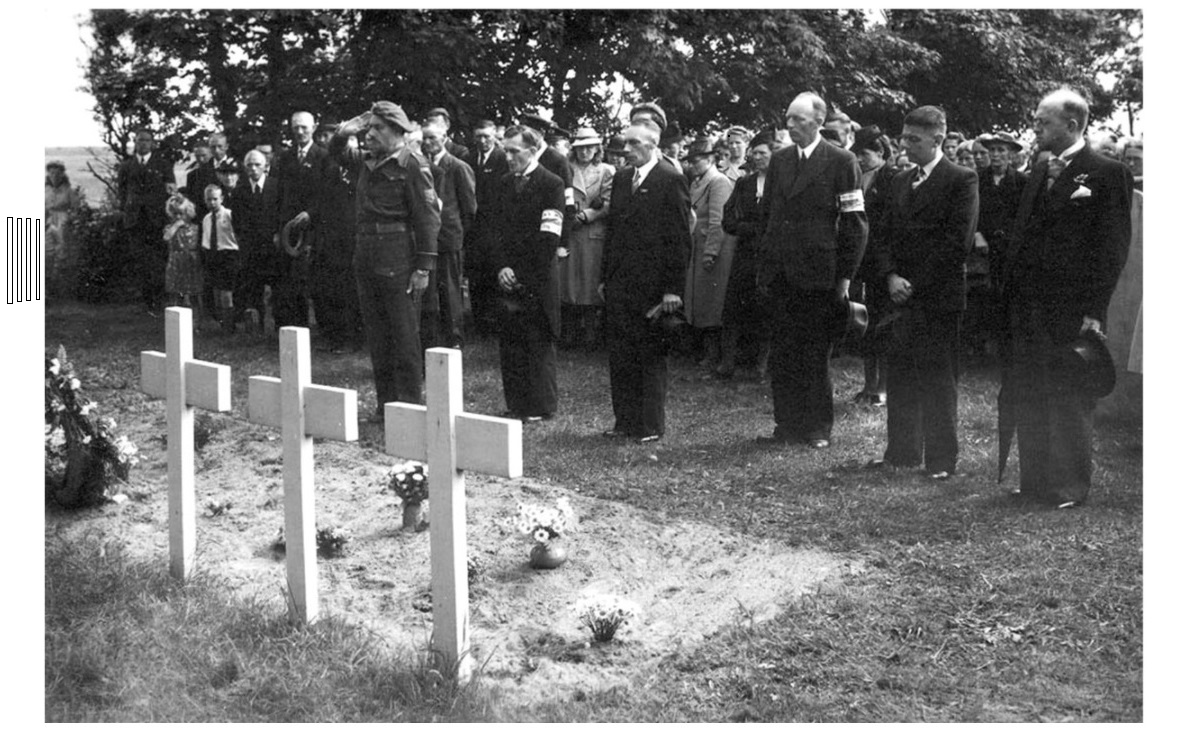
K.
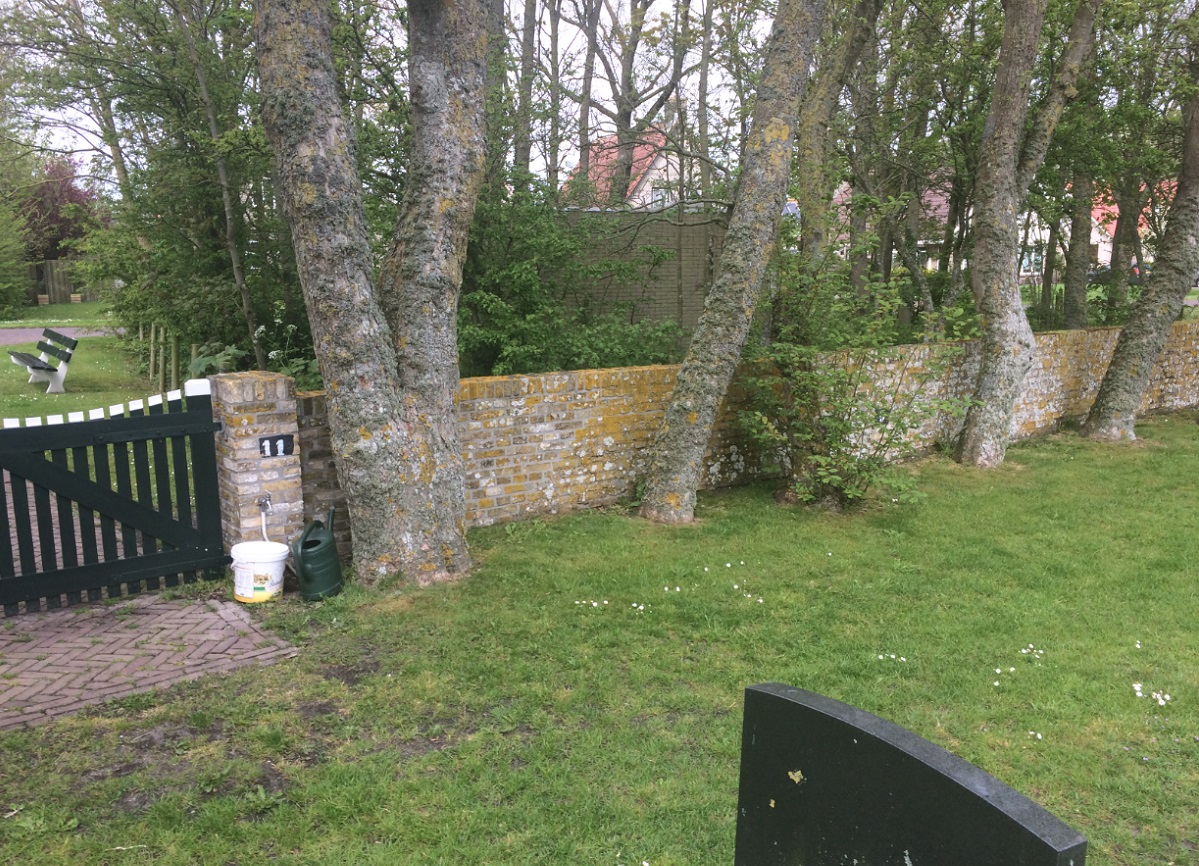
N.
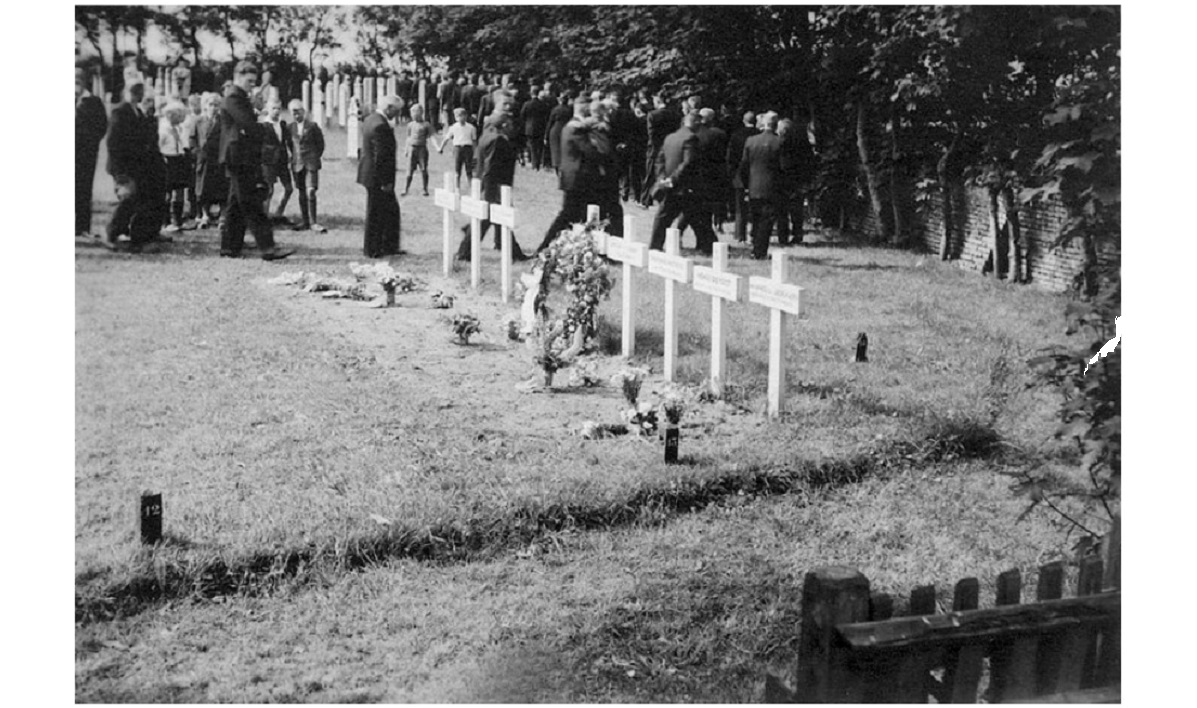
L.
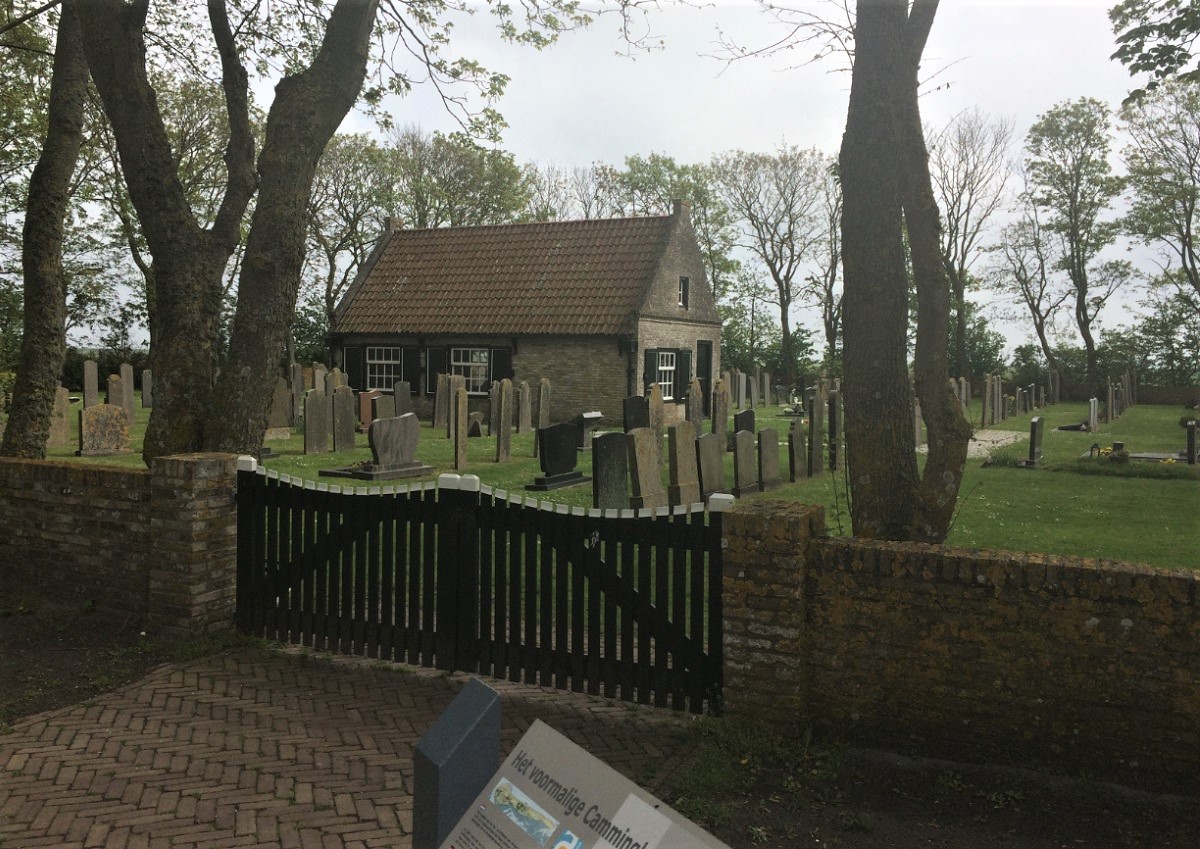
The French soldiers were moved from Ballum to Kapelle in 1949. The two Commonwealth men to CWGC Jonkerbos in 1952.
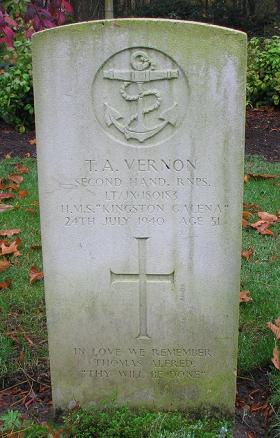
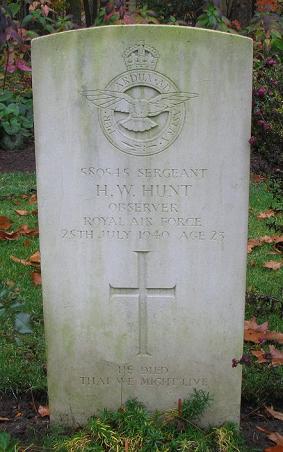
Hollum
A
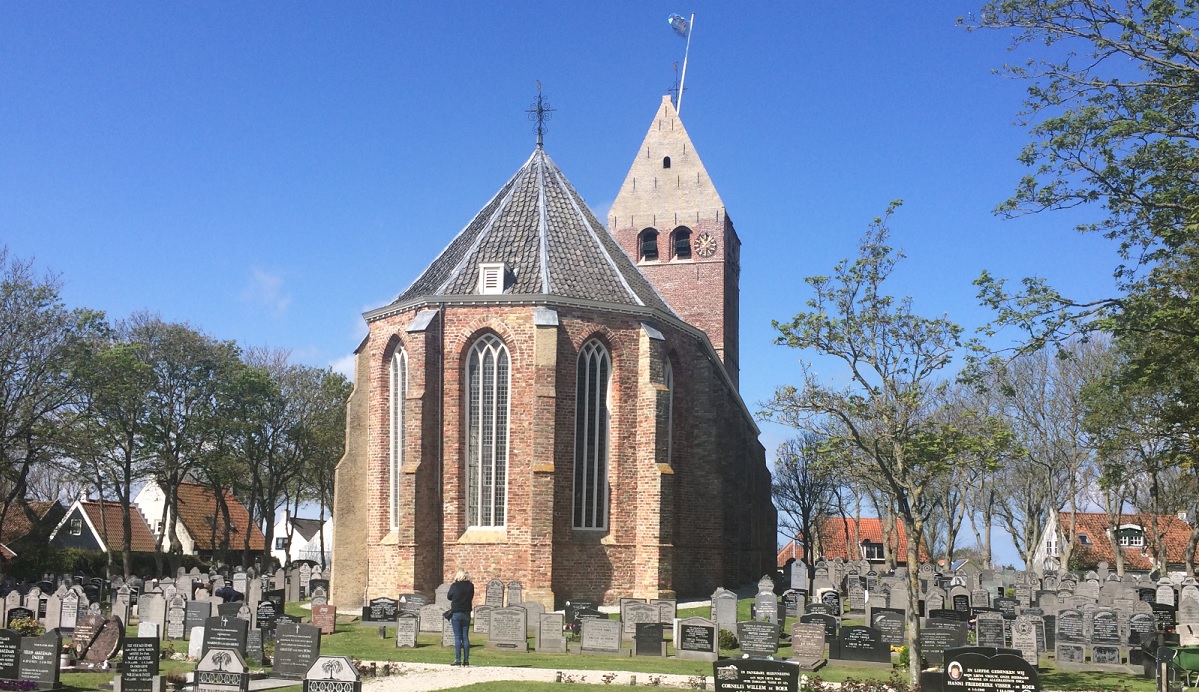
B
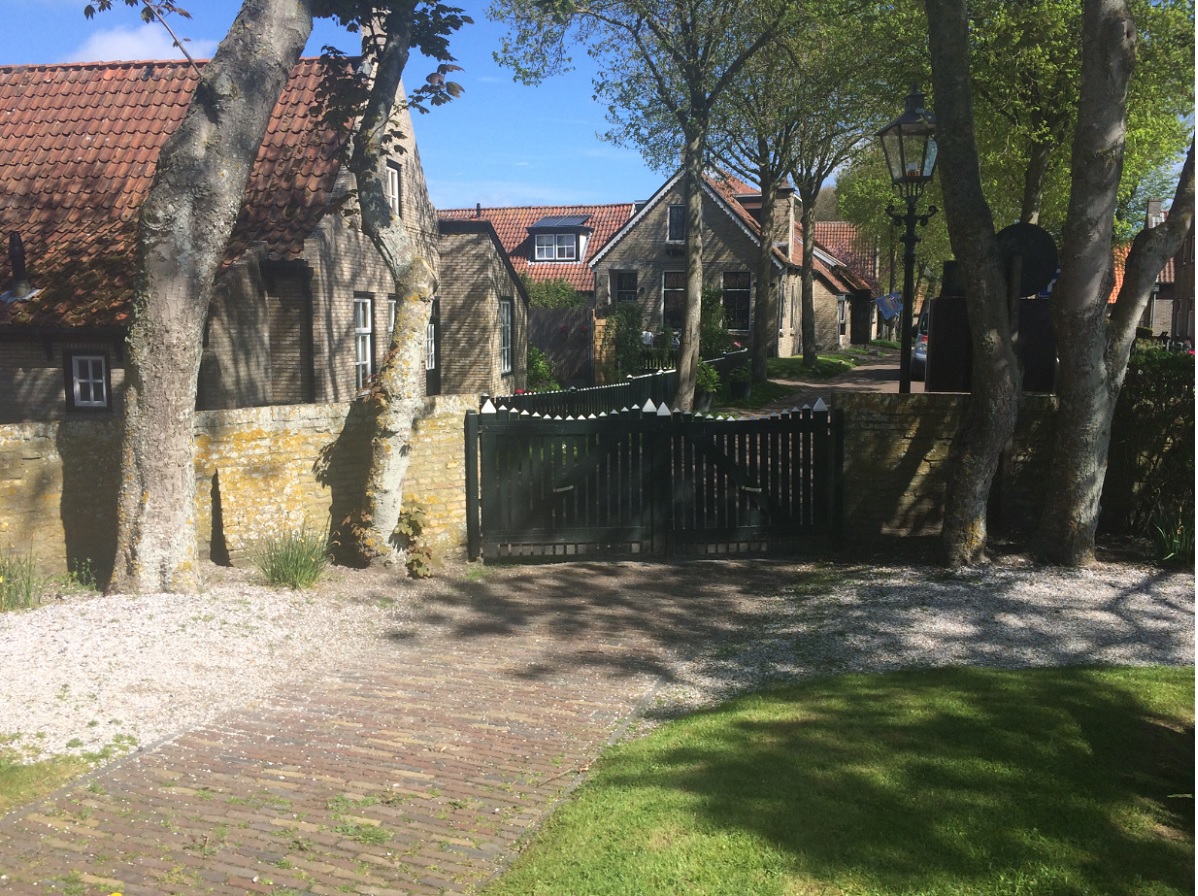
C
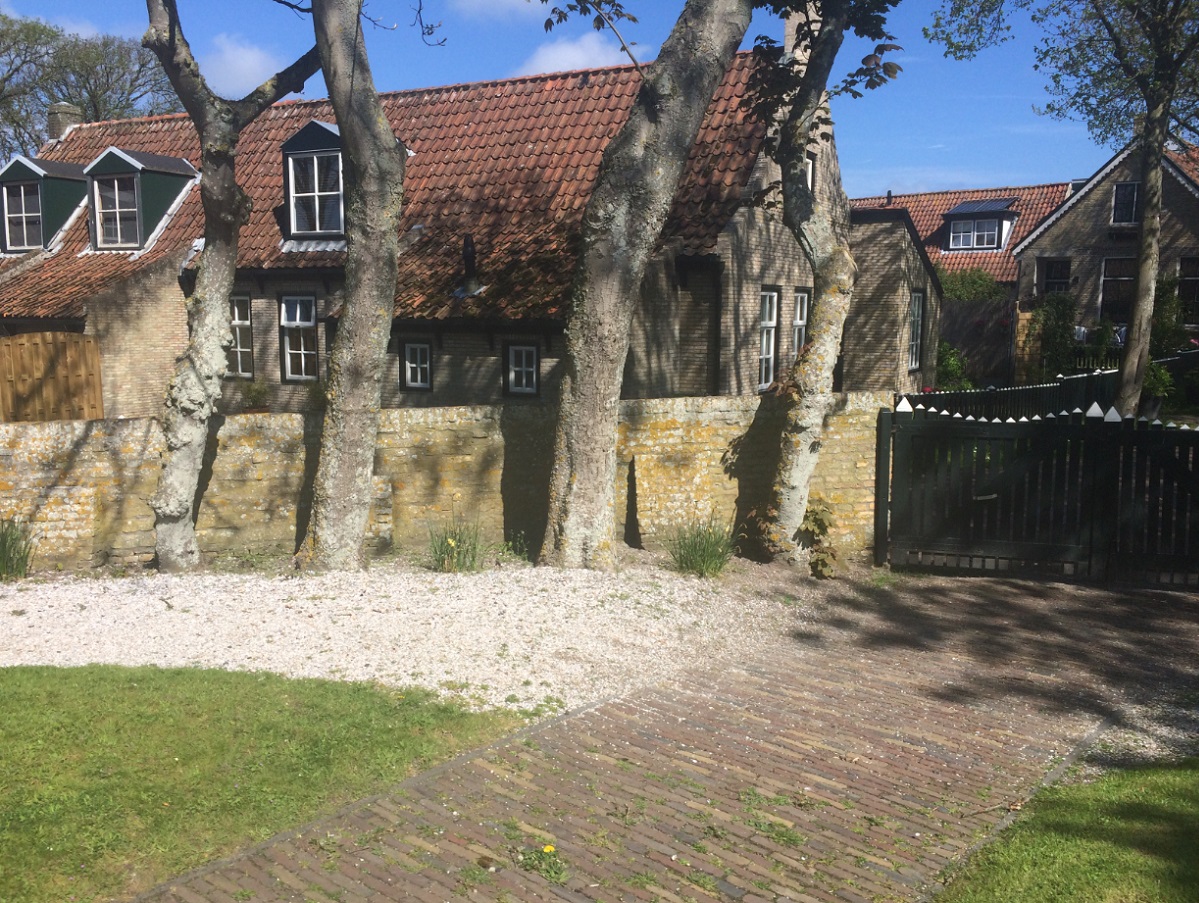
D
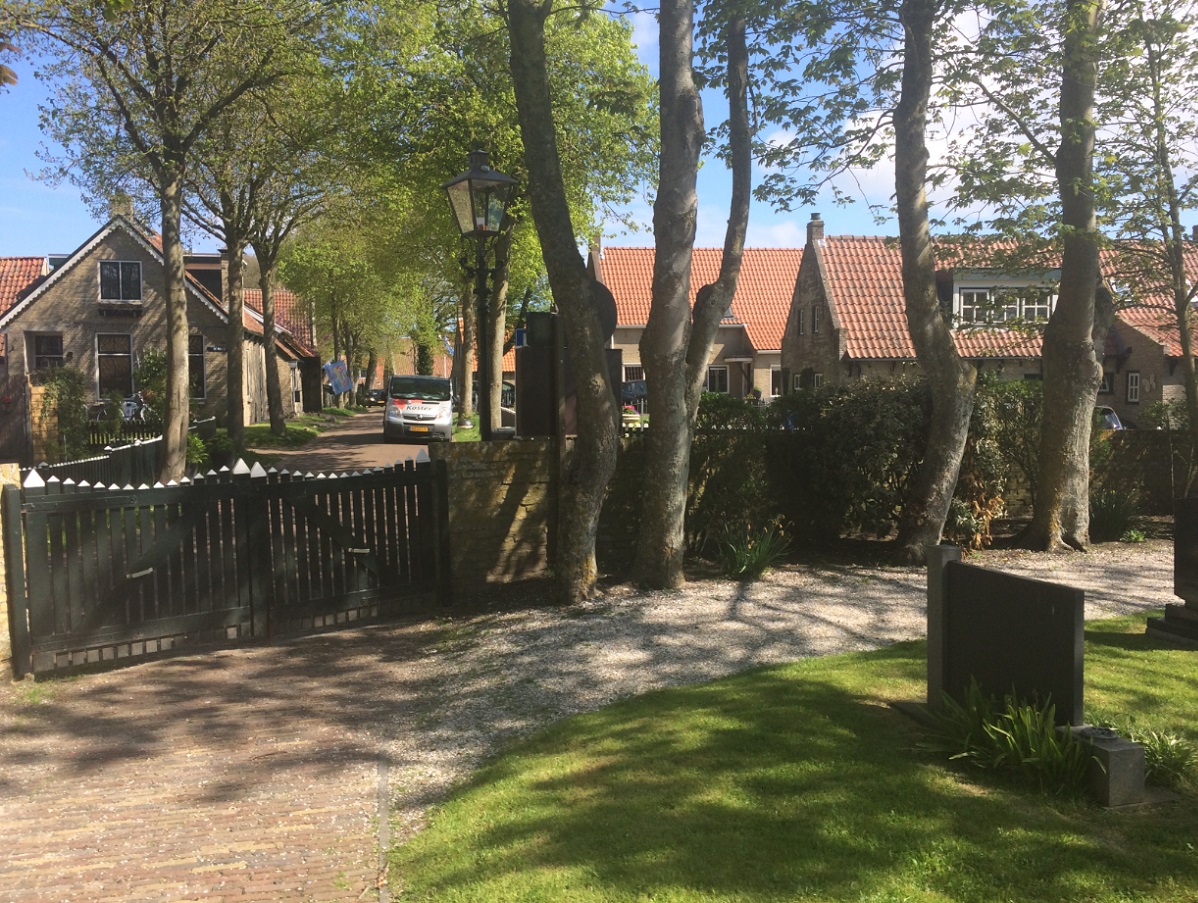
E
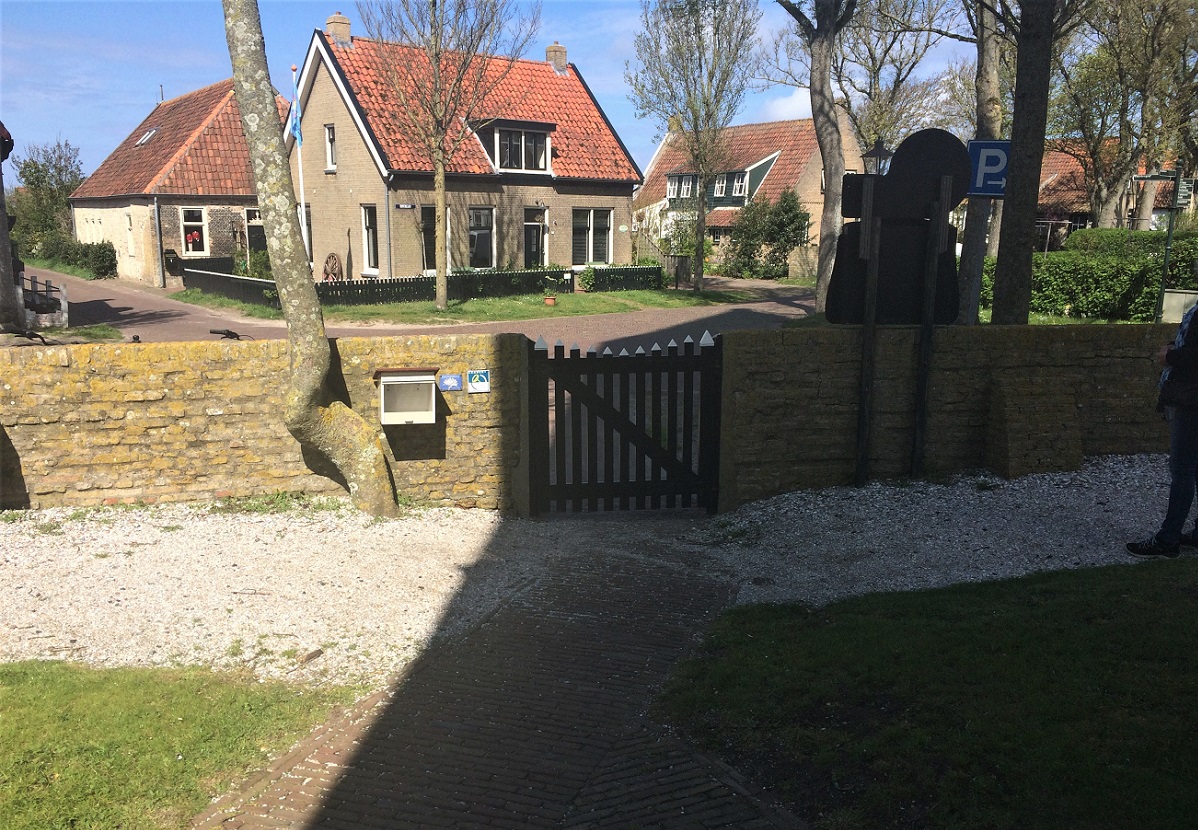
Z
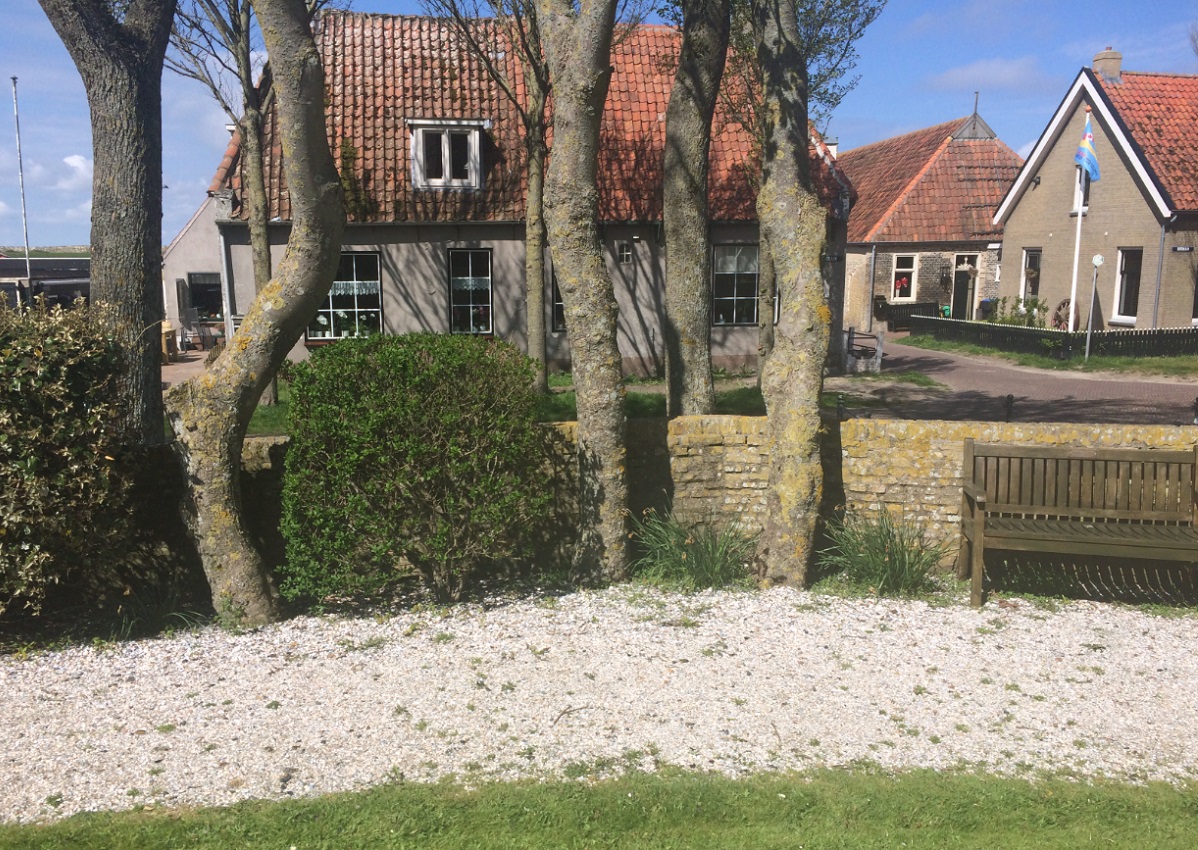
G
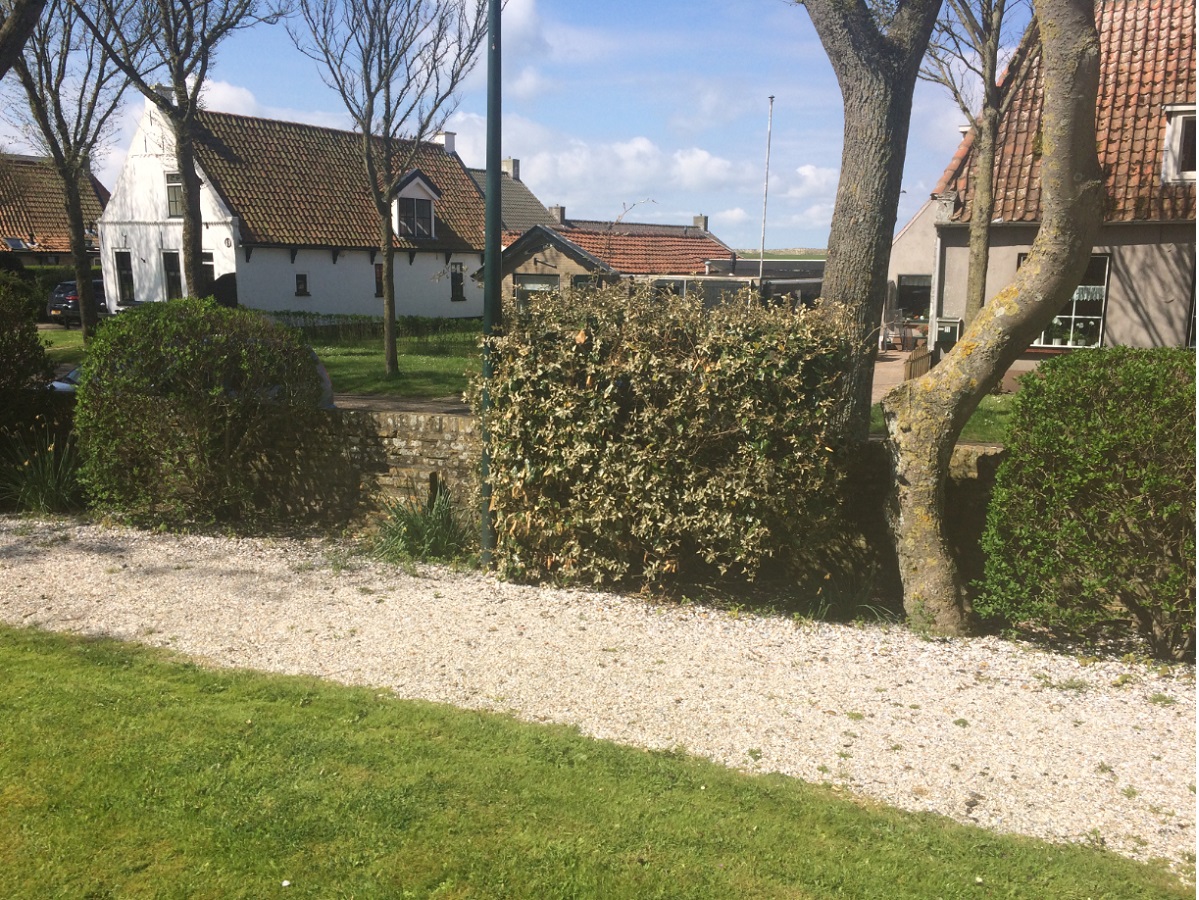
H

J
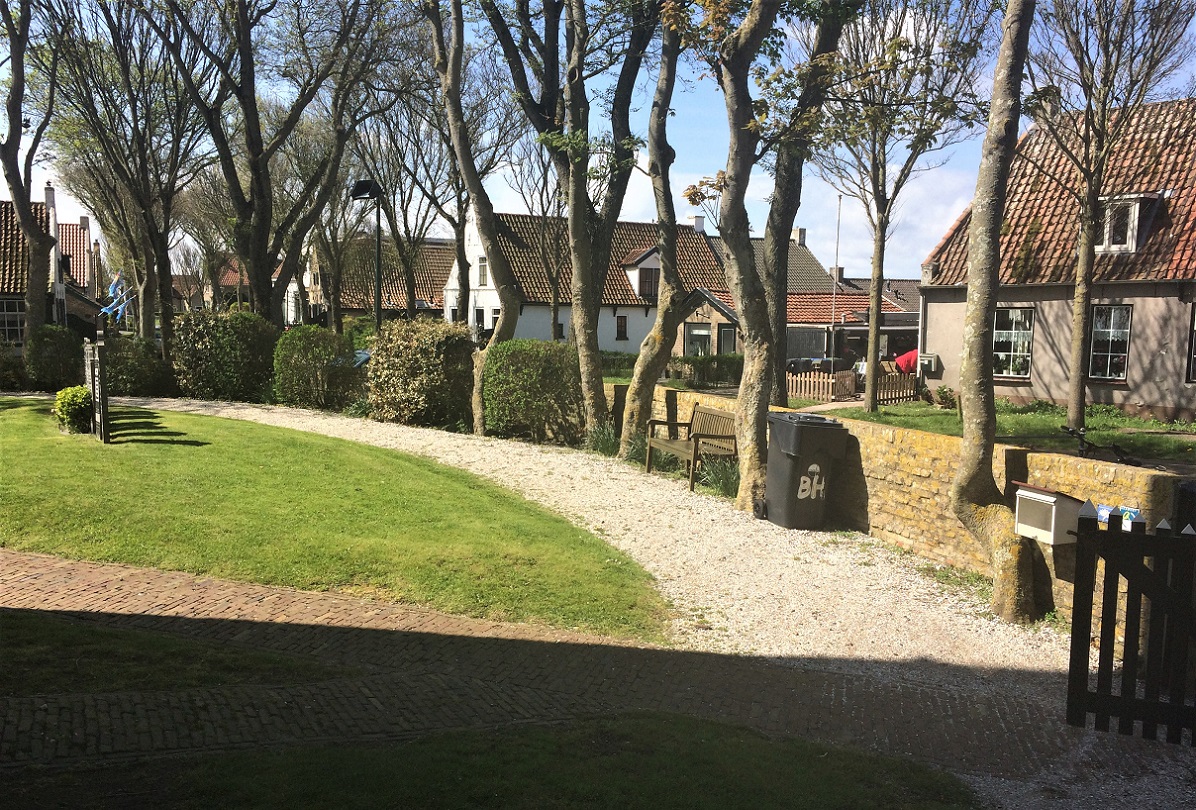
Q
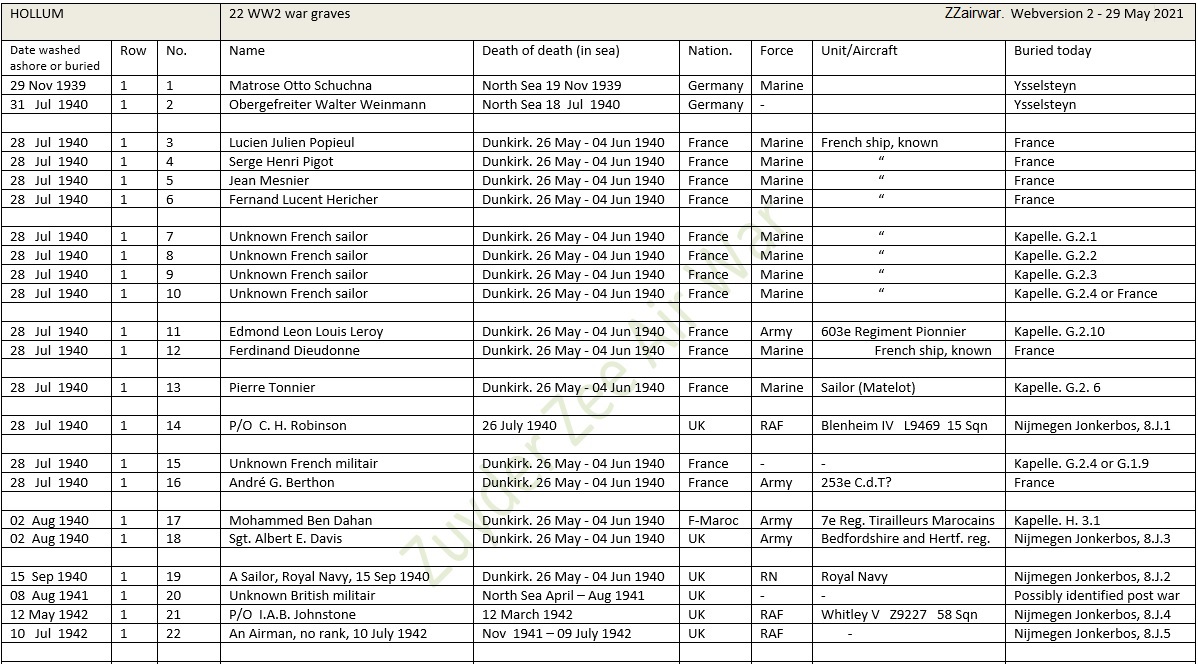
K
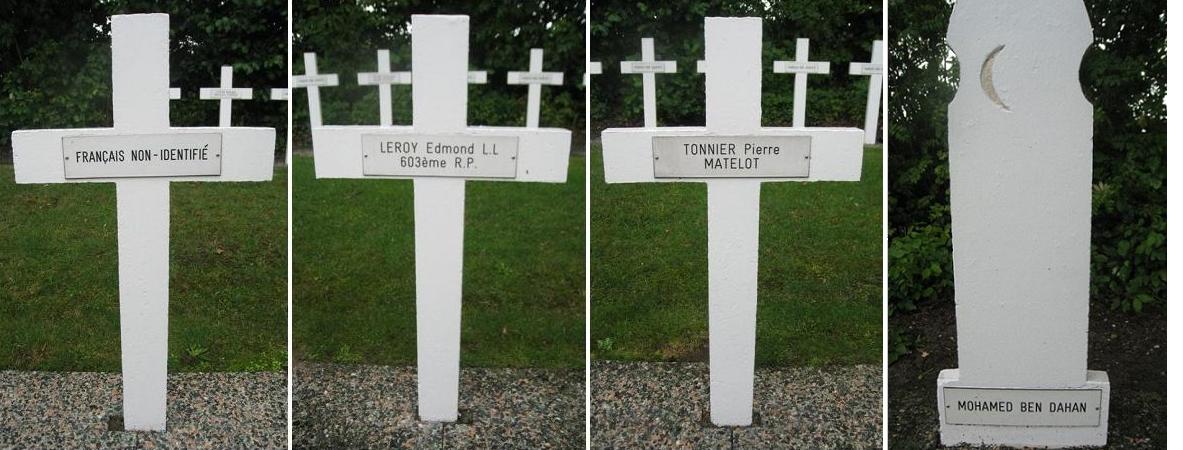
L
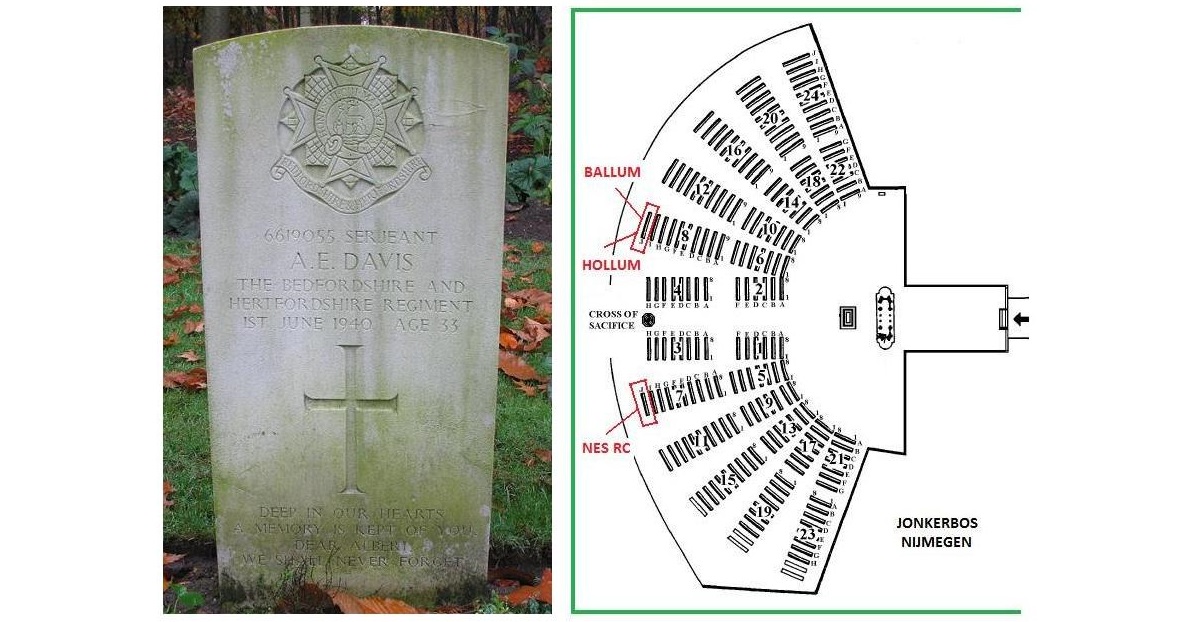
Headstone of Sgt. Albert Edwards Davis in Jonkerbos CWGC Nijmegen. Washed ashore, buried 2nd of August 1940 at Hollum, grave 13, see above scheme. His name is on the wartime wooden cross photo above right.
.
NES RC
Nes village, Roman Catholic cemetery, St. Clemens church. Address: Kardinaal de Jong weg 33.
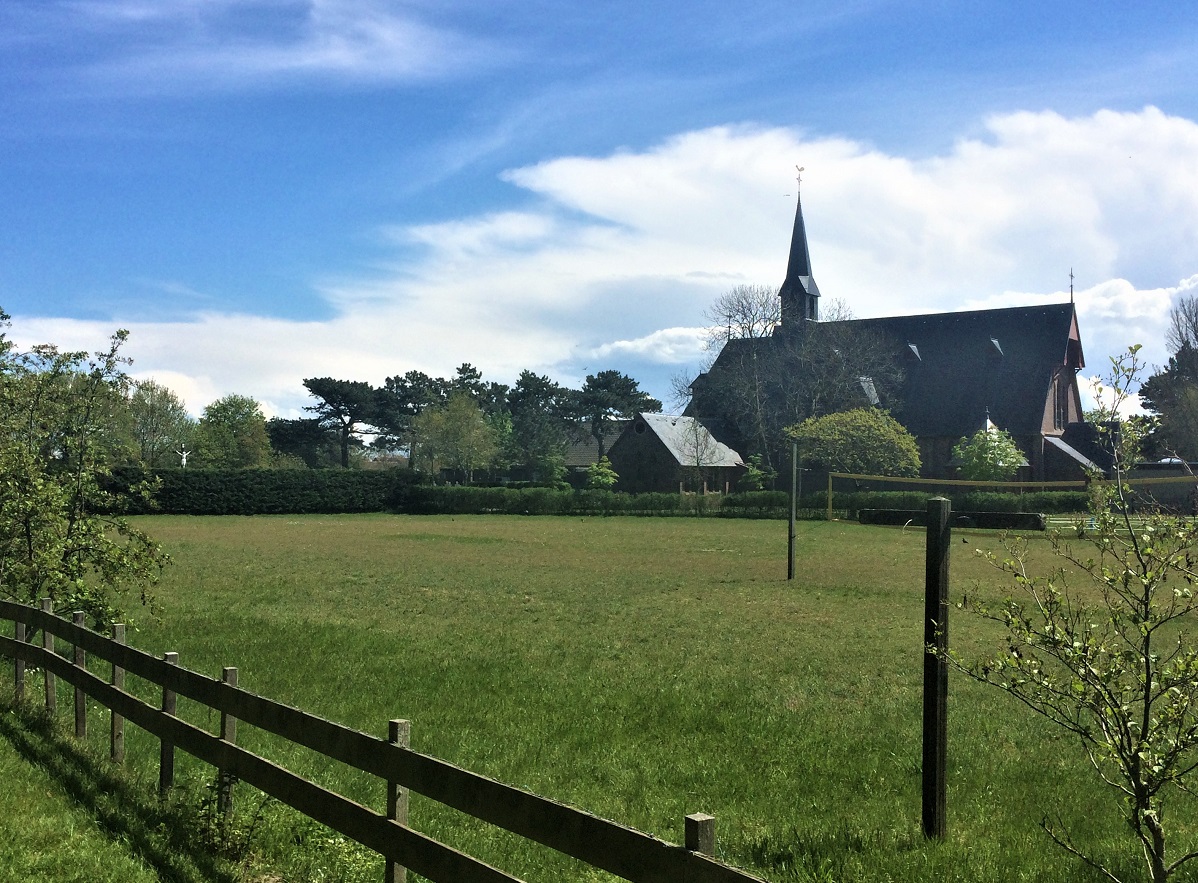
Photos shows the church, rebuild after fire in February 2013.
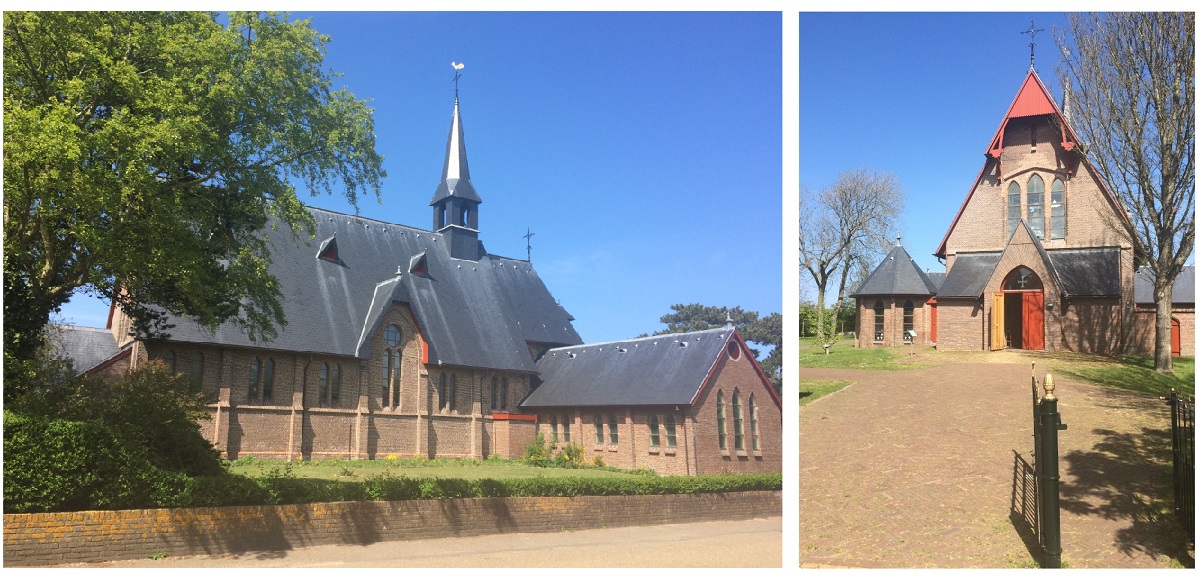
C.
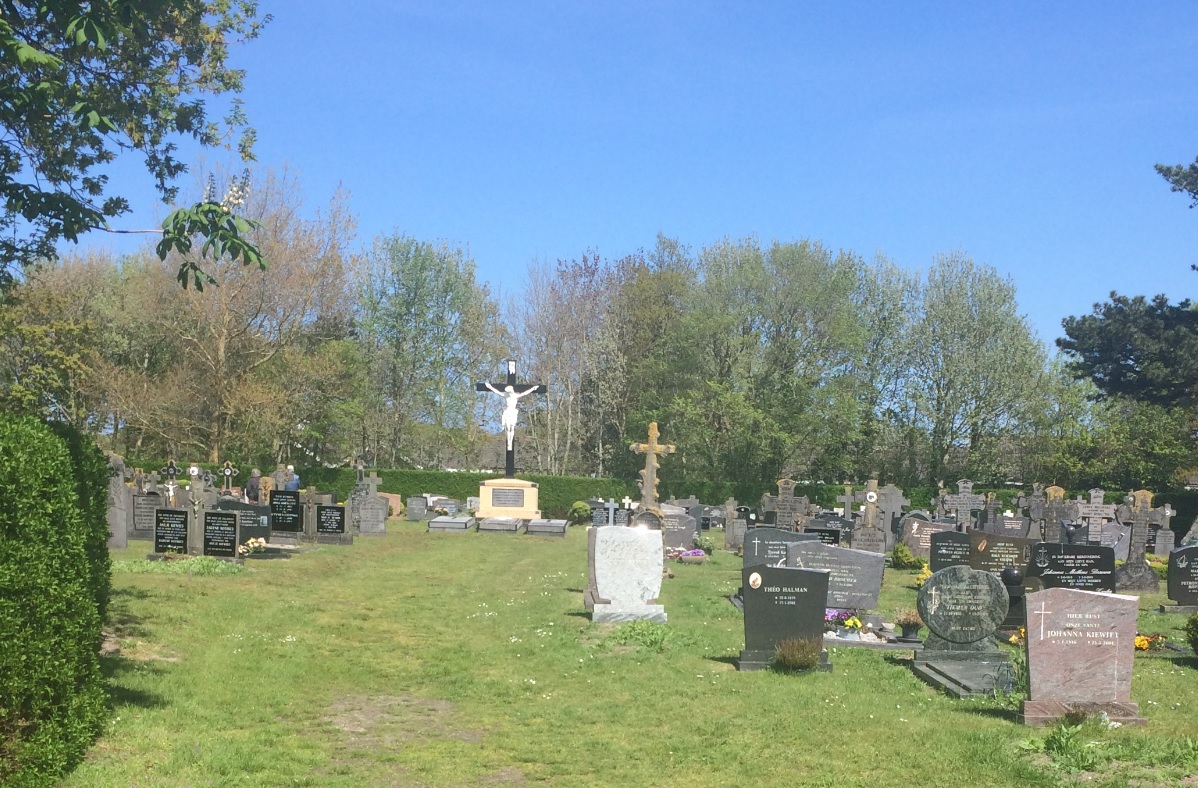
Photo below left: photo dates 11 August 1940. The first grave is the German grave, which still is here today. On the cross is readable "Regierungsinspektor aKR Dr. Josef Wille". The German occupation force on the island put a vase with flowers at the cross and covered it with pine-tree branches in his honour. Photo below right: Four Allied soldiers after the war at the same row of crosses, photo taken from another angle.

K

N.
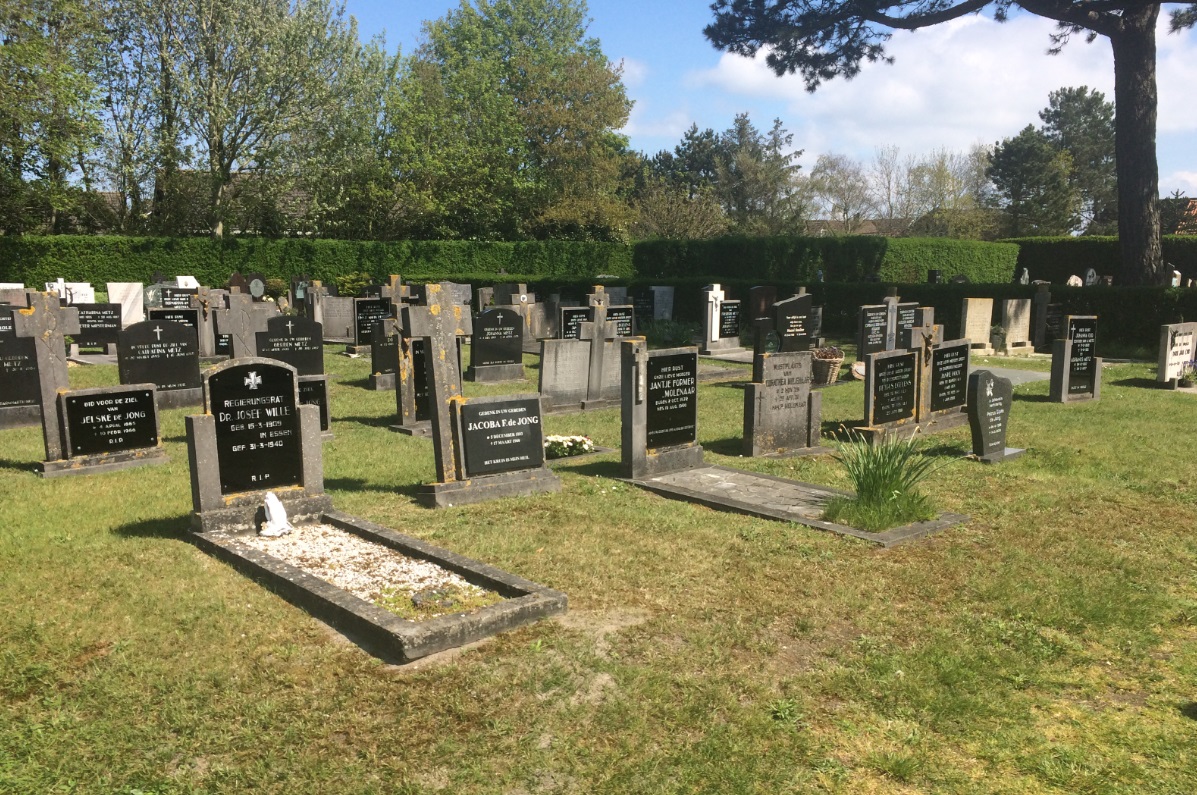
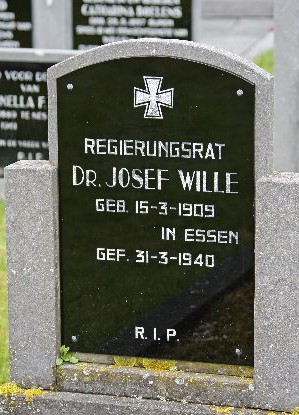
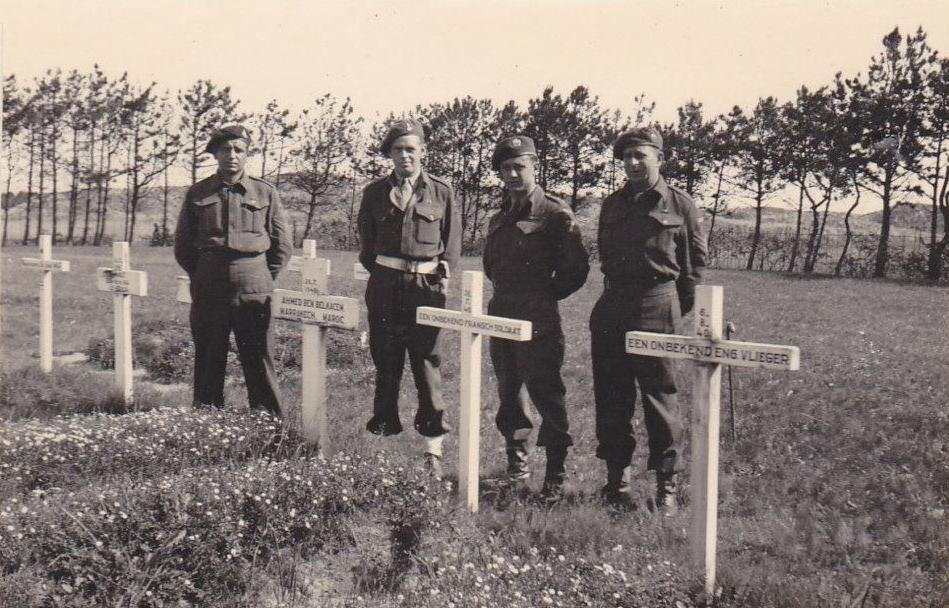
Dr. Wille was officially not a German soldier, he was a civilian weather specialist, hired-in by the Luftwaffe. When the German war dead on Ameland island were exhumed (about 10 men) and centralized in Ysselsteyn in 1958, Dr. Wille stayed behind and is still here. Remarkable is 1). the German cross on his stone, 2). 'GEF.', meaning 'Gefallen' (Fallen in battle) and 3). the R.I.P. (English) below. He is one of the few Germans in the Netherlands buried outside the German centralisation War Cemetery Ysselsteyn. See our article on Ysselsteyn for more info on this. Probably the Wille family paid for eternal grave rest in Ameland before 1958 and therefore Wille's remains could legally not be moved.
These four Allied soldiers are possibly French-Canadian. They pose behind grave nr. 4 with Ahmed Ben Belkacem, Marrakech- Maroc and grave nr. 5 with an unknown French soldier buried 31-7-'40. The cross most right mentions '8. 8. 40 EEN ONBEKEND ENG VLIEGER', meaning: '8 August 1940 (wash ashore date) an unknown English flyer'. He was post war identified as F/O David Lusk.
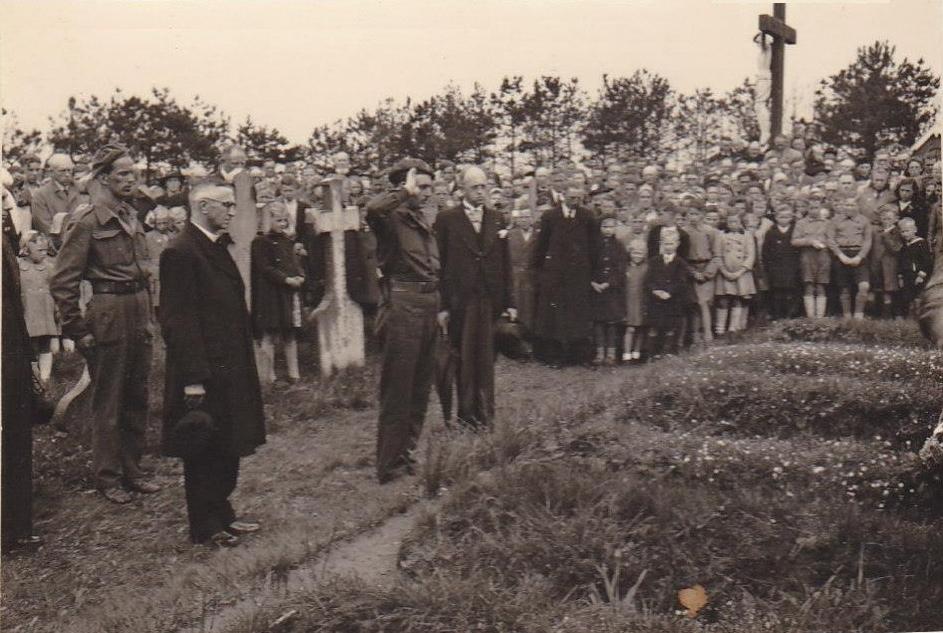
Nes Roman Catholic cemetery 1945. General Simonds has laid a wreath at the most centre cross of the row at grave nr. 6 (photo below) and salutes. His lieutenant is standing behind him at the attention. The Dutch crowd carefully follow the General's every move.
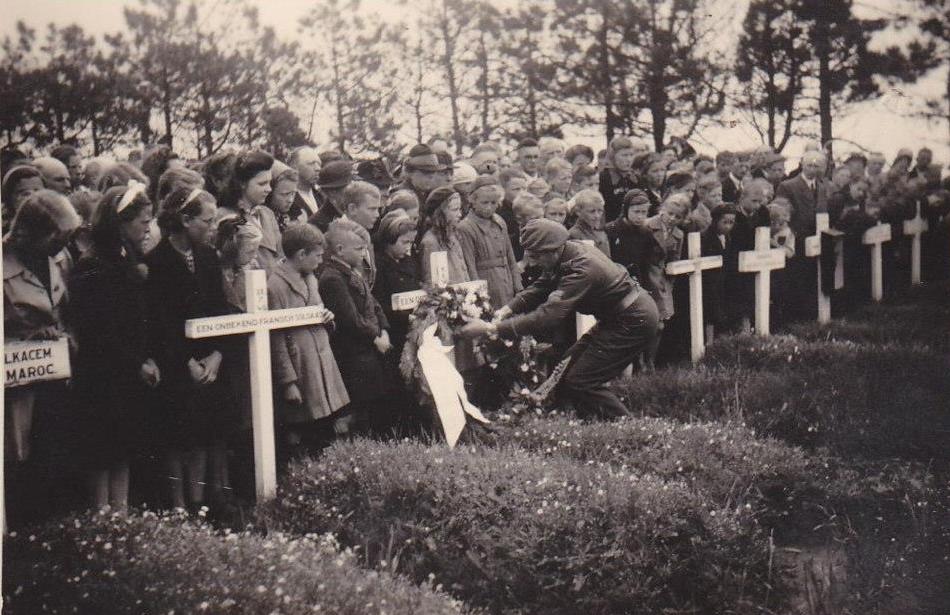
Photo right: the grave visible most left is of Ahmed Ben Belkacem (Marrakech, Maroc). 263th French-Moroccan rifle Regiment Tirailleurs Morocains, died at sea on evacuation Dunkirk - France begin June 1940. Washed ashore and buried here 28 July 1940. Below his grave today in Kapelle, NL.
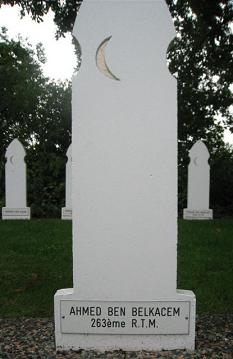
Four crosses further (right side of the General) are Polish airmen, in grave 7, 8, 9 and 11. See details in above scheme on Nes RC. Below photo's show their graves in Nijmegen today.
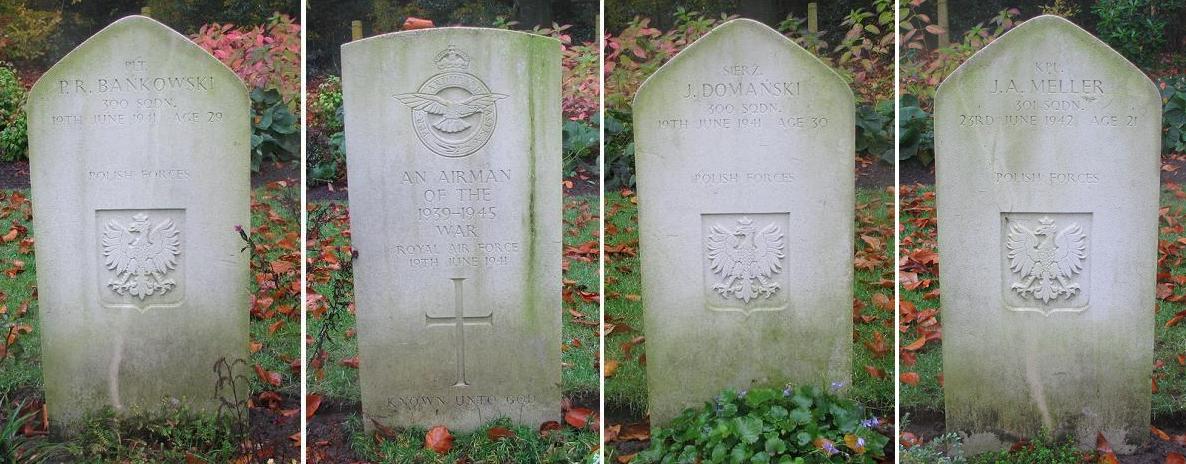
Above the headstones of the 4 Polish airmen that initially lay on Nes RC. They were reburied at Jonkerbos cemetery in Nijmegen in 1952. Apparently it was was not possible to identify Polish airman Walenty Sieckza for 100% by name or being of the Polish Air Force (PAF). He received a CWGC RAF headstone and was buried as Unknown, but between his crew mates Bankowski and Domanski. Polish corporal Meller is from another aircraft. He washed ashore exactly a year later. 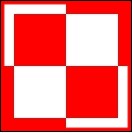
Except for the German grave of Dr. Wille, all war graves on Nes RC were cleared in 1949 and 1952.
P.s. 14 November 2019 the Unknown RAF airman between Plt. Bankowski and Sierz. Domanski was officially recognized (CWGC case 177c 'Accepted') as their crew member Sgt. Walenty Sieczka (Wellington W5665). We published our research on him on this website in 2016. We hope it contributed.
The four RAF/RCAF airmen from Nes RC, today Jonkerbos Cemetery Nijmegen.
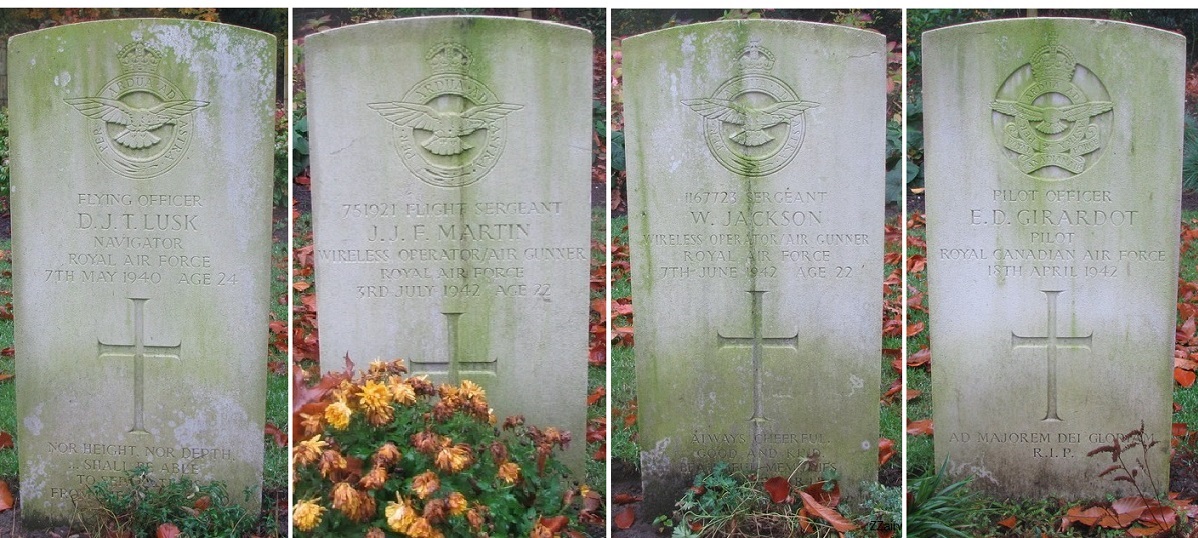
.
NES GENERAL CEMETERY
Nes tower in the centre of the village.
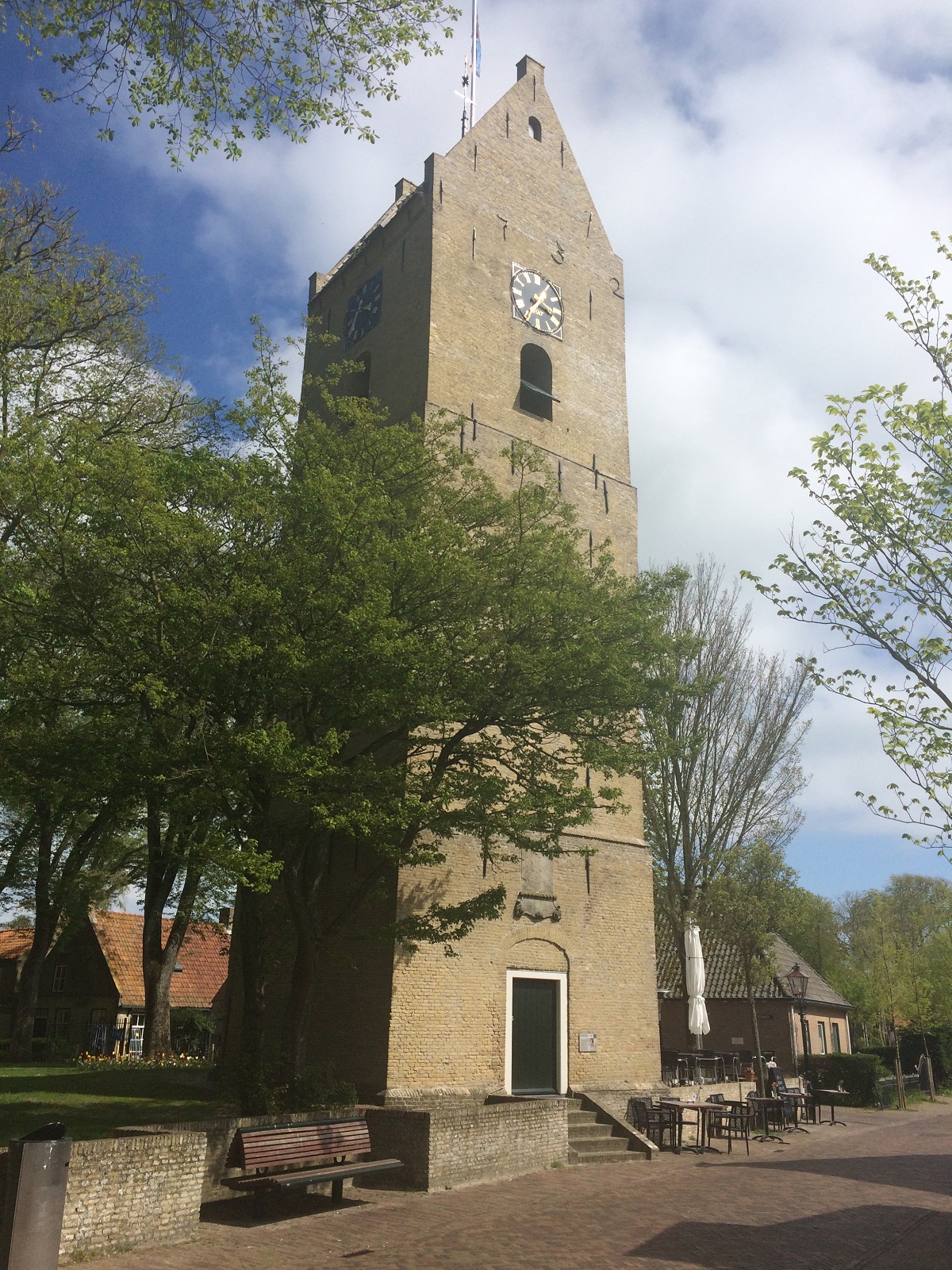
Entrance Nes General Cemetery. As all cemeteries on Ameland, the war graves are directly at the entrance.
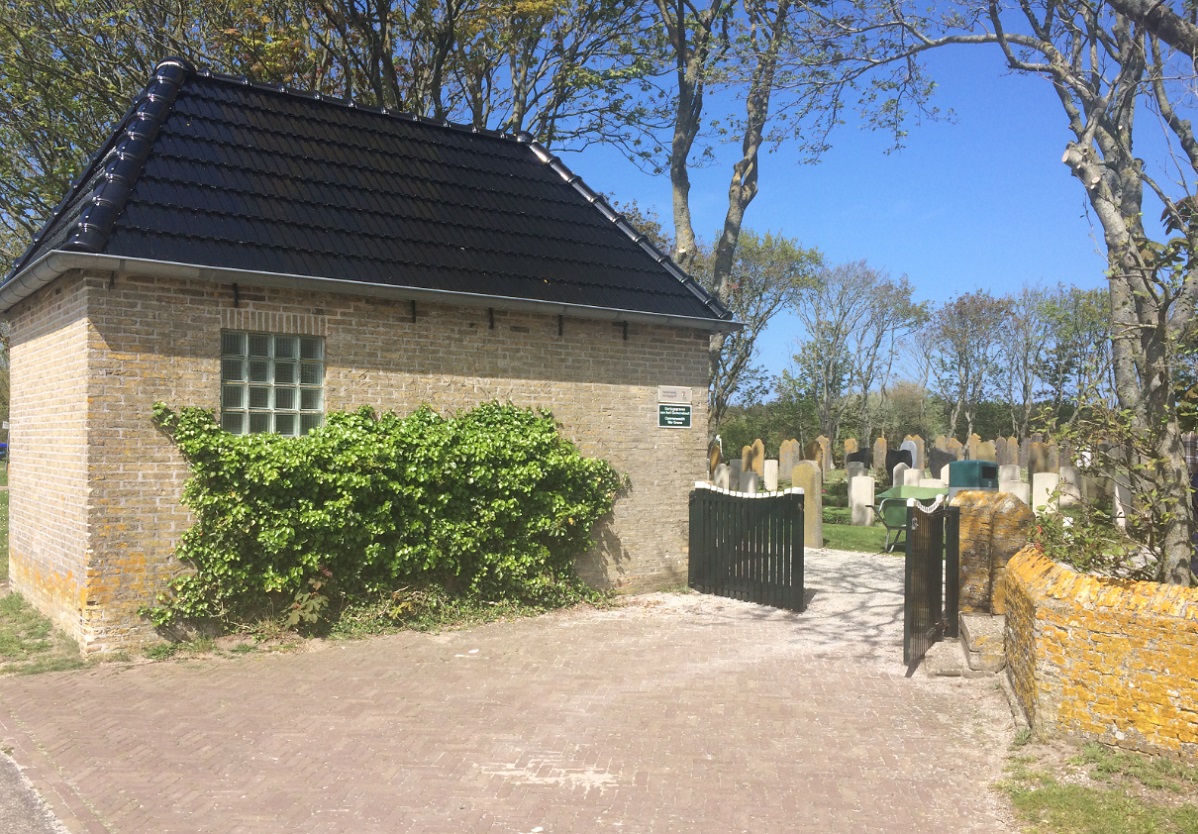
Overview. Empty spaces at the flagpole are the exhumed French Dunkerque graves.
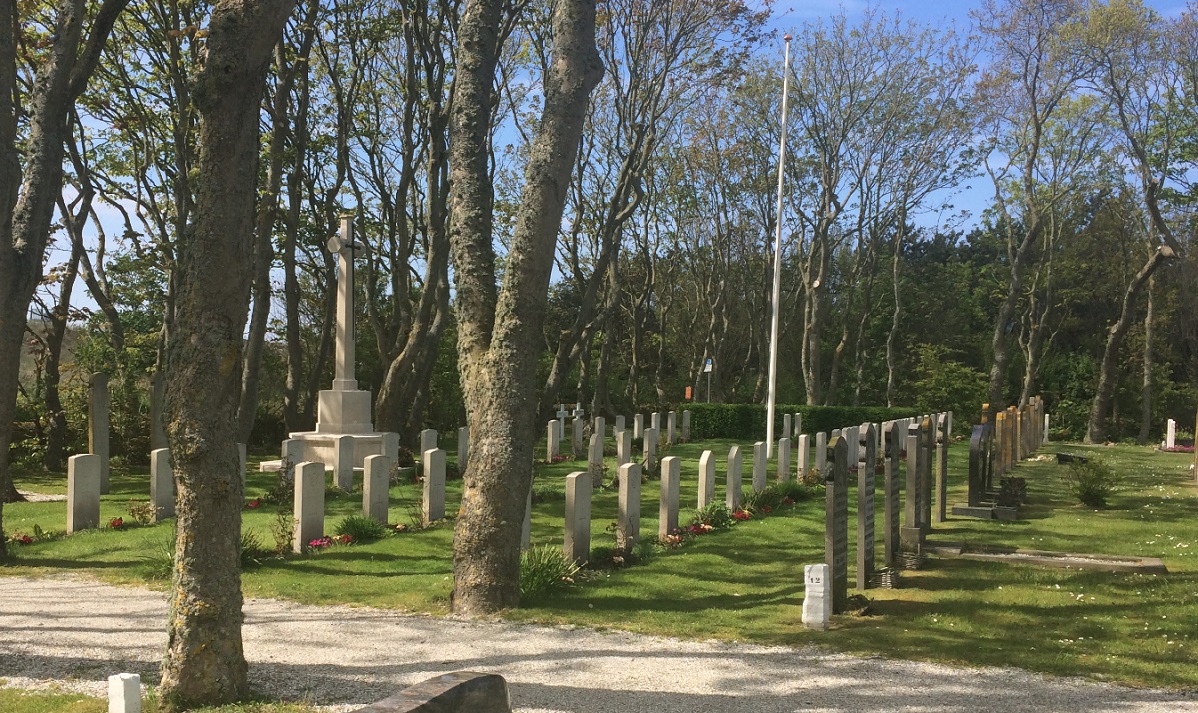
Nes General, Braamduinerpad 13. This cemetery is positioned between Nes and Buren alongside a path that is leading into the dunes.
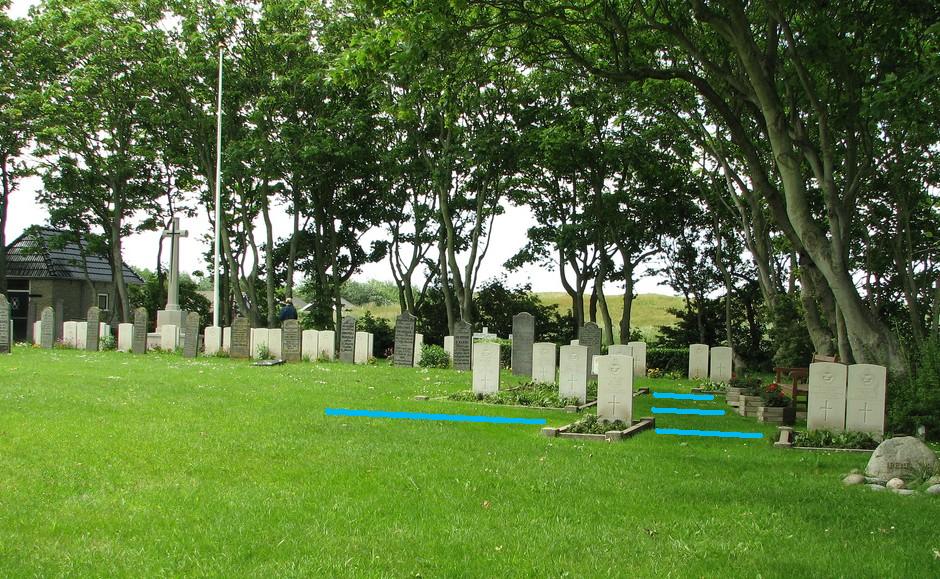
Overview of Nes General cemetery
The French row was in the centre from the flagpole towards the trees on the right.
The blue lines indicate the position of the cleared USAAF graves.
Today the general cemetery in Nes contains 48 identified Allied war dead, including the Dutch Lt. van Gorp. There are also two unidentified Polish airmen and 19 Commonwealth Unknown, bringing the total on 69 men. Info on the 2 Polish airmen is further below. In the right corner in the back of this cemetery are also graves of two German sailors from the 1950's.
THE DUNKIRK VICTIMS
Photo below: this black and white picture is dated August 28th 1940. What we see is the first and at the time the only row (row 14) with Allied casualties on Nes General cemetery. 19 Dunkirk victims are buried here end July 1940 (under the heaps of sand). On the day of this photo, a month after their burial, the white crosses are ready and placed next to the small black poles that indicate the grave number. In the back a man is inspecting the first white cross placed (by him), which must be on the grave of French sailor René Garet.

.
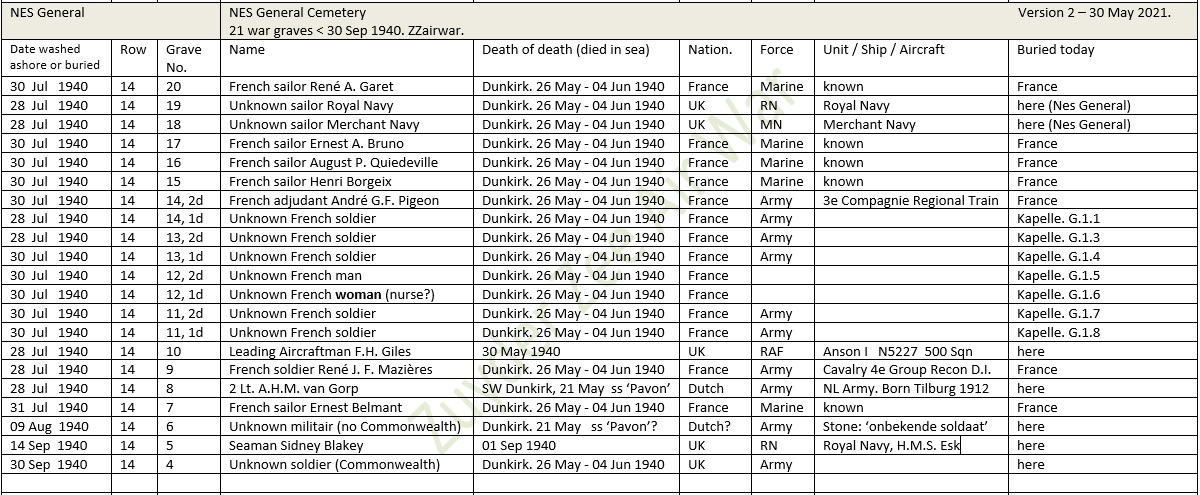
Photo below: Nes General Cemetery, in the afternoon of the 28th of August 1940: the first 15 Allied crosses on Nes General are placed in position. Four graves contain two coffins and their crosses have two inscriptions. On this day in August 1940 the cemetery contained 18 men and one woman, in total 19 Dunkirk victims. The woman remained unknown but was moved in 1949 to the central French war cemetery in Kapelle (NL), so apparently she was French. Maybe a nurse on board one of the ships evacuating Dunkirk. In the month September another soldier was buried, bringing the total number of Dunkirk victims on this cemetery on 20.
On the last cross (nearest to the camera) can be read: 'een onbekende Franse? soldaat', = 'an unknown French? soldier'. This man was not identified in 1949 as French nor as Commonwealth. He was lowered again in his grave 14.6 and received a very unusual grave marker; a rectangular stone with on it (in Dutch) 'ONBEKENDE SOLDAAT' = 'unknown soldier, 1940-1945'. On the second cross is written 'ERNEST BELMONT'. Real name was Ernest Belmant. On the third cross 'A.H.M. v GORP'.
On 3rd June 1952 the mayor of Ameland wrote he had three Dutch soldiers buried on his island: 1 in Nes (2 Lt. van Gorp), 1 in Ballum and 1 in Hollum. We believe that with the (Dutch)man in grave 14.6, there could have been Dutchmen, the fourth without his knowing. Two of the Dutch have probably been reburied in their home town, as for example Lt. Bastiaan de Zeeuw was in Oudenhoorn. We believe the four Dutch were on their evacuation-ship the ss 'Pavon' which was hit by a bomb on 21 May 1940 and was beached near Hemmes de Marck/Hemmes d'Oye between Calais and Dunkirk. But they survived and were 4 June on the Emile Deschamps.
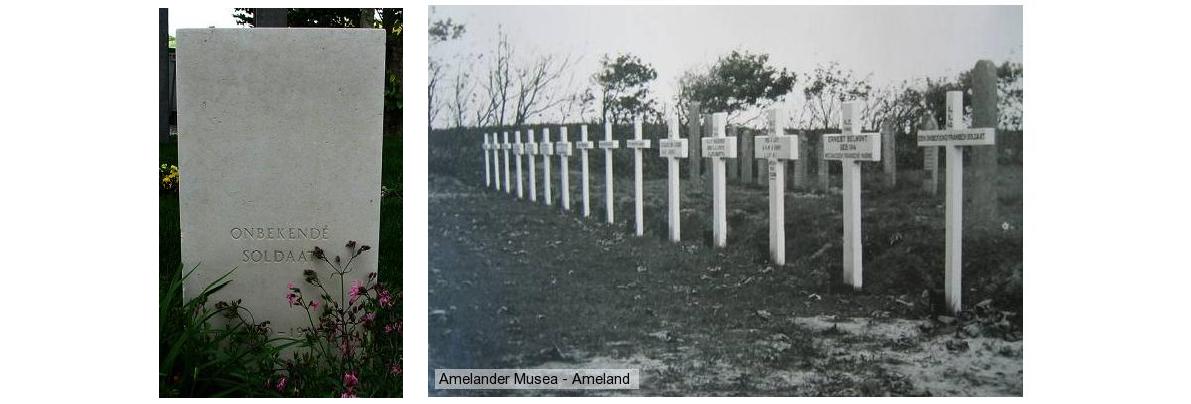
Photo above: after the above picture was taken, this row was expanded on this side in September 1940 with two more graves: Royal Navy Seaman S. Blakey and an unknown British soldier on the 30th. Because the French were exhumed in 1949, this row, although positioned today in the centre of the war graves plot, is empty and without grave stones.
1945 COMMEMORATION ON NES GENERAL. Canadian General Guy Simonds.
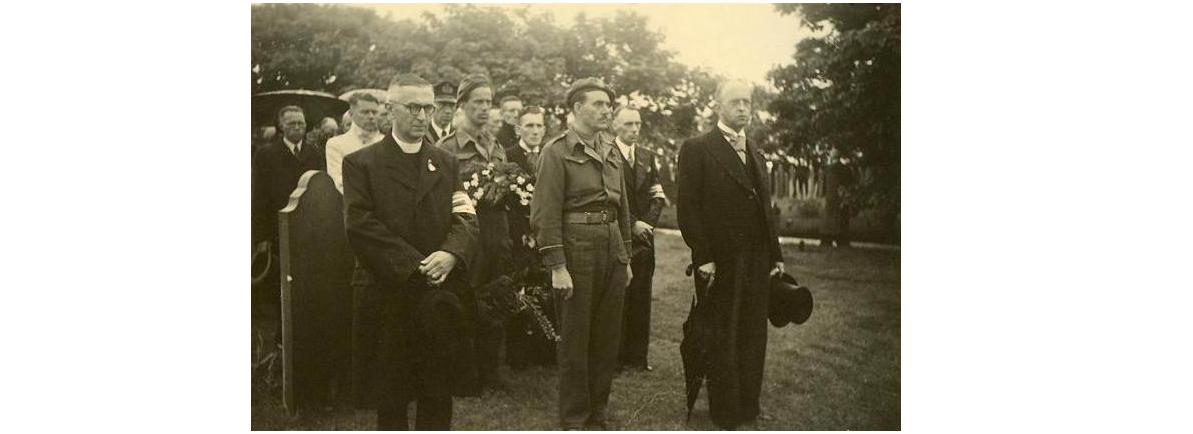
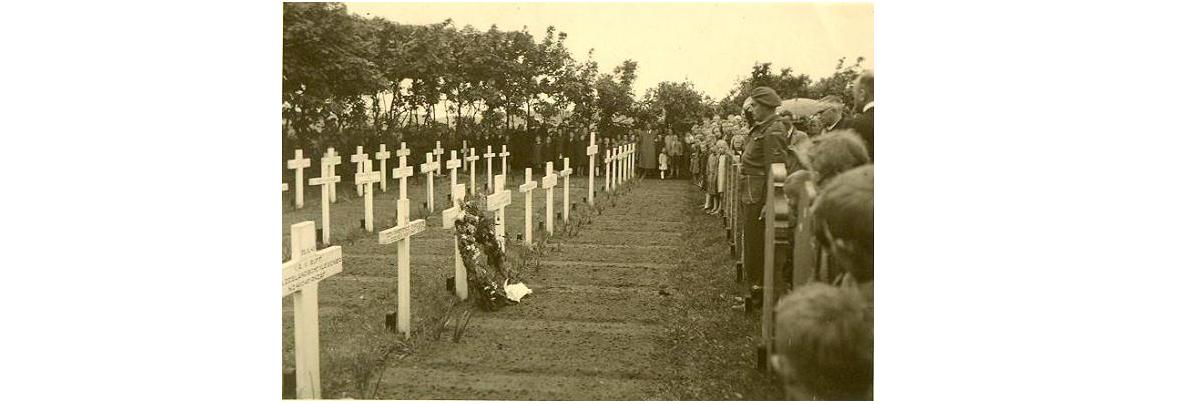
Photo above: Commemoration 1945. The initial row with French crosses from 1940 has become the centre row on the cemetery. Behind and it front of it new rows with crosses formed during WW2. The officer with beret, General Guy Simonds, has placed a wreath central on the front row and salutes. This is the grave of F/Sgt. Alfred J. Down, RCAF, killed 2nd March 1943 and washed ashore here later. To the left of him is the cross of Sgt. John R. Glendinning. On the cross visible most left is engraved: "I.R.V. Ruff, Nieuwzeelandse vliegenier, NZ airf RNZAF'.
Photo below: The General salutes at the grave of F/Sgt. Down. Third and fourth cross the left are two unknown Polish airmen in grave nr. 5 and 6.
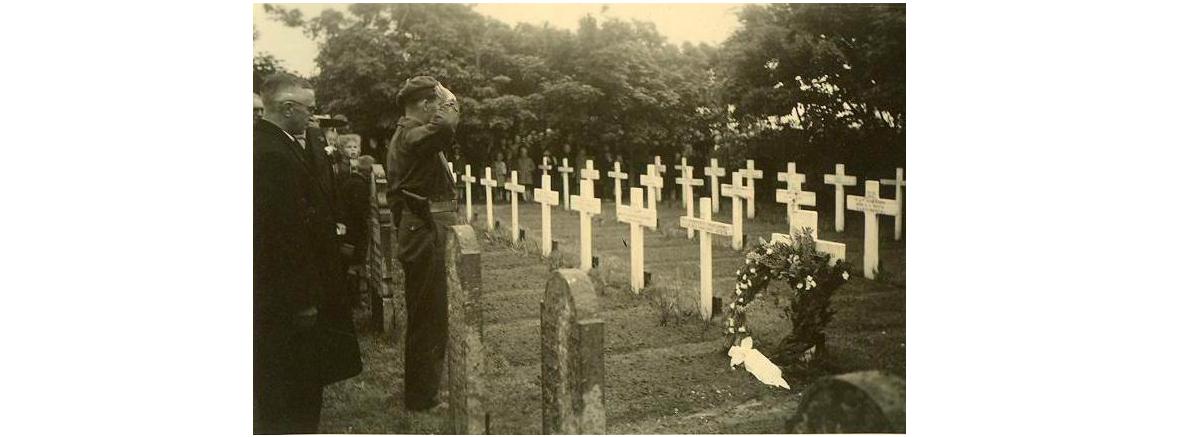
Today.
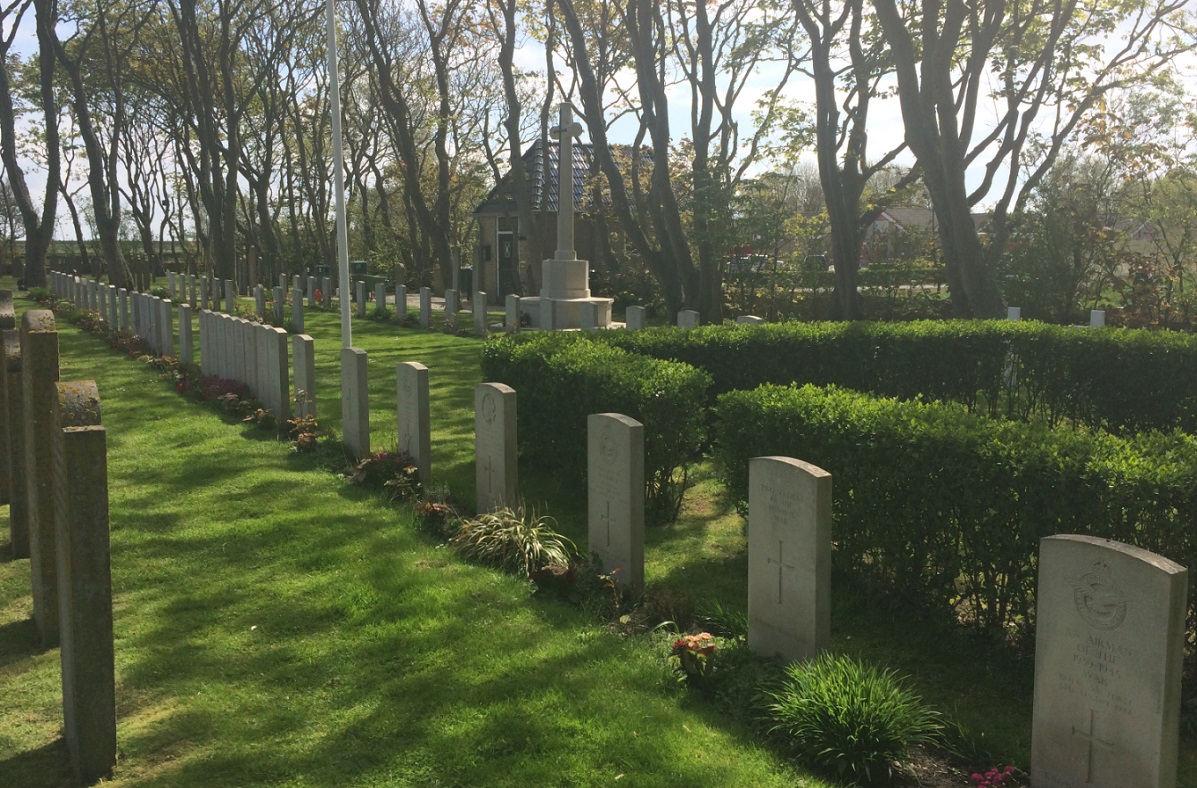
THE TWO POLISH UNKNOWN ON NES GENERAL
Today's headstones on the front row (row 13) of grave 5 and 6: the two unknown Polish airmen, never identified. The Pilot Officer (Porucznik) washed ashore on July 2nd 1943 and the Sgt. on the 10th of July 1943. These important dates are not marked on their headstone.
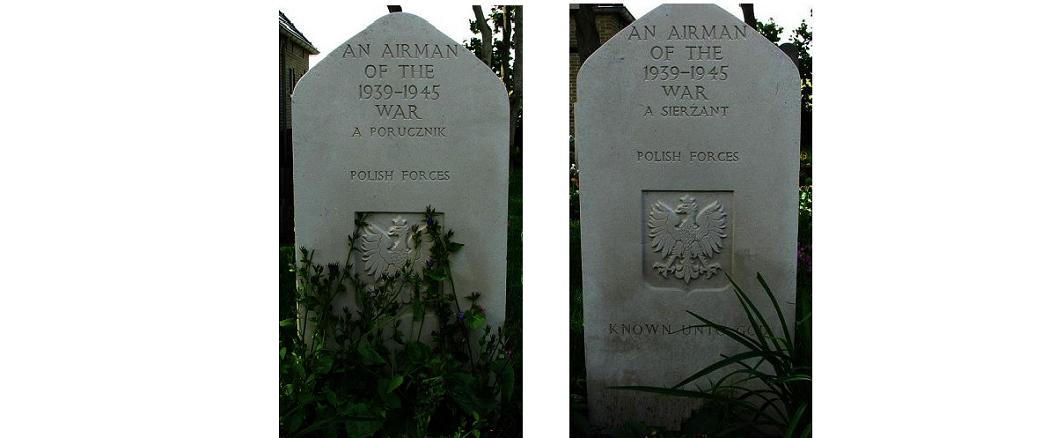
It is believed the officer (left stone) is Pod-Porucznik (ppor. pil.) pilot Stefan Tomicki. If this was correct, then the other man (washed ashore 8 days later) could be a Sgt. of his crew, either Sgt. Wladyslaw Marczuk or Sgt. Tadeusz Kniazycki. However, evidence is thin and further research on this is necessary. Aircraft was Polish 300 Sqn Wellington HE148 which came into the North Sea 10 miles from the Dutch coast off Wijk aan Zee in the night of April 8/9 1943. Four crew members (1 unknown) of this aircraft were brought by the sea to the beach of Kennemerland-north & Petten and buried in Bergen aan Zee.
For more info see site Polish War Graves.nl article on Nes-Ameland
THE AMERICANS ON NES GENERAL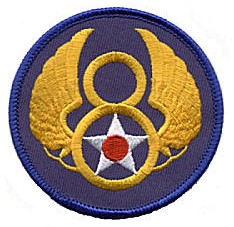
Eleven American airmen were buried here at the end of the war. 7 of them washed ashore on various dates. Their grave position is marked in blue on the photo further up.
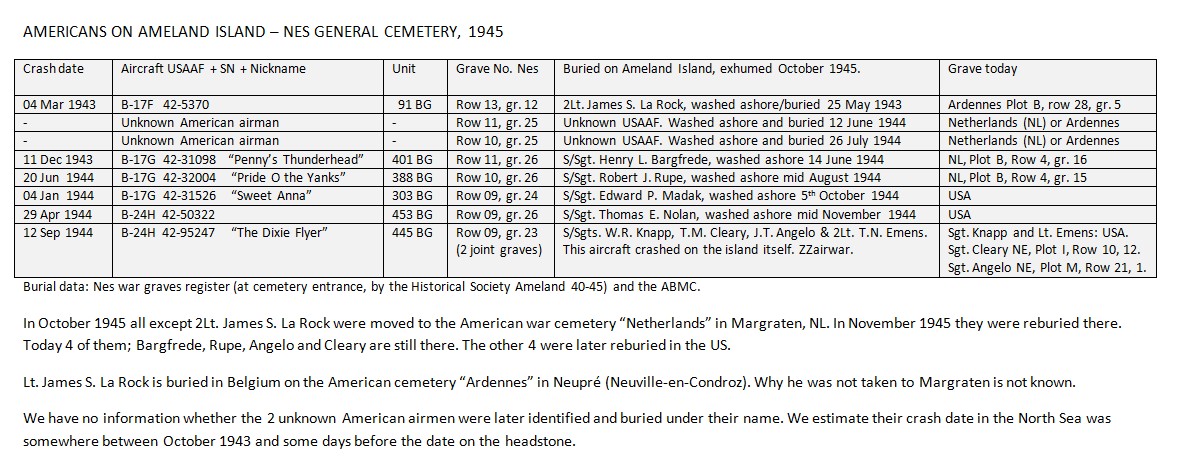
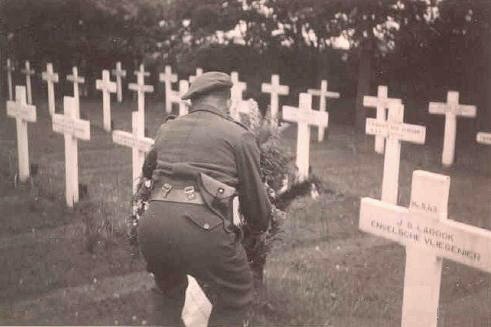
Photo right: The officer lays flowers at the grave of Canadian F/Sgt. Down. Text on cross right:
24. 5. 43
J. B. LAROCK
ENGELSCHE VLIEGENIER
translation: 24 May 1943, J.B. Larock, English aviator.
USAAF 2Lt. James S. La Rock washed ashore after Sgt. Down and was the first American buried here (see his data in above scheme). At that time the Germans and the people of Holland were unaware of the start of the American bomber offensive and buried the first American airmen in their unknown flying suits as 'English airman'. That would soon change.
The fact that Lt. La Rock was buried early in 1943 and as Englishman, can be the reason that he is buried as only American from this cemetery in "Ardennes" (the others on "Netherlands", Margraten, NL). An English airman J.B. Larock May 1943 could not be explained here and he was taken to the US-identification centre in Neuville-en-Condroz. There he was identified and buried to this day on B.28.5.
THE UNKNOWN
For more info on the 21 unknown (23 including the two Americans) on Nes General see our database 'Buried as unknown' in the Search menu.
THE FRENCH WAR DEAD LEAVING AMELAND 1949
After the war the French government decided to assemble all their war dead in the Netherlands (as the Americans). Family could choose for return to France or reburial on the central French war cemetery in the Netherlands in Kapelle. In August 1949 a French army grave recovery unit arrived on Ameland and exhumed their countrymen on all four cemeteries on the island: Hollum (13), Ballum (7), Nes Roman Catholic (4) and Nes General (14). The remains were layed into new coffins and on a rainy day in August these were loaded on flat bed trucks for transport to the ferryboat.
On the 15th of August 1949 the trucks with French coffins are leaving Nes village and Mayor Walda is laying flowers on behalf of the people of Ameland. The truck with civilian Dutch (Frisian) license plate B-34774 was registered on 11-11-1948 on company Firma Jacob Wagenaar & son in Nes.
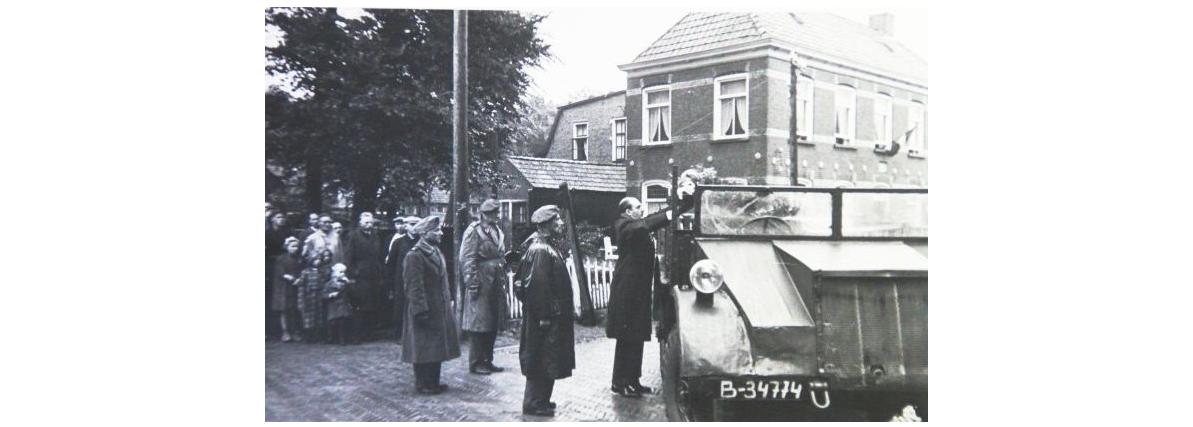
Respectfully he procession is moving up the road towards the ferry. French soldiers of the grave recovery unit are marching alongside the trucks and trailers. People from the Island are following. The vehicle in the centre is an army Chevolet C60 and the civilian registered truck up front an old English Army Guy-Ant.
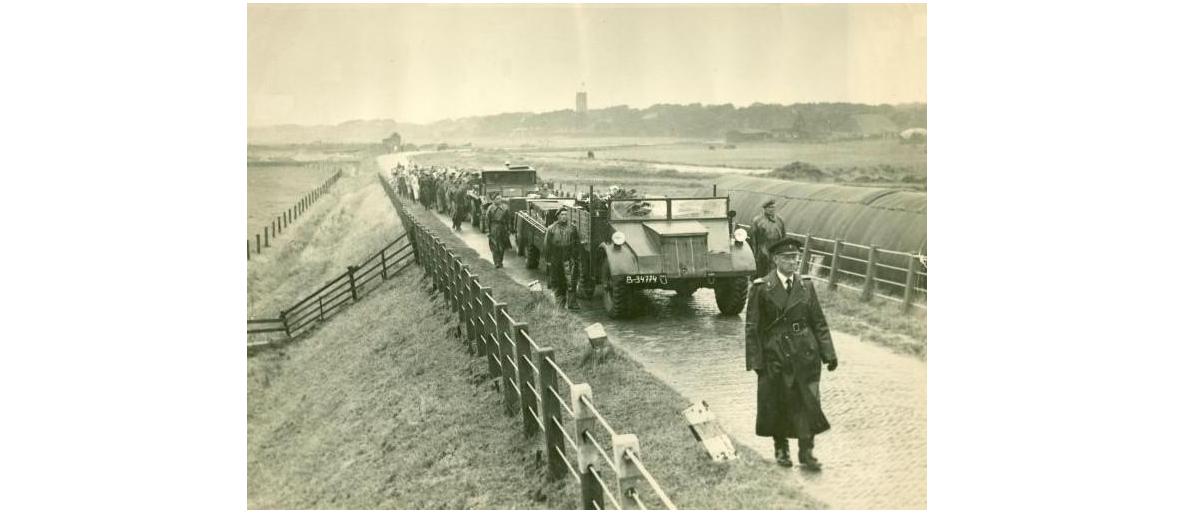
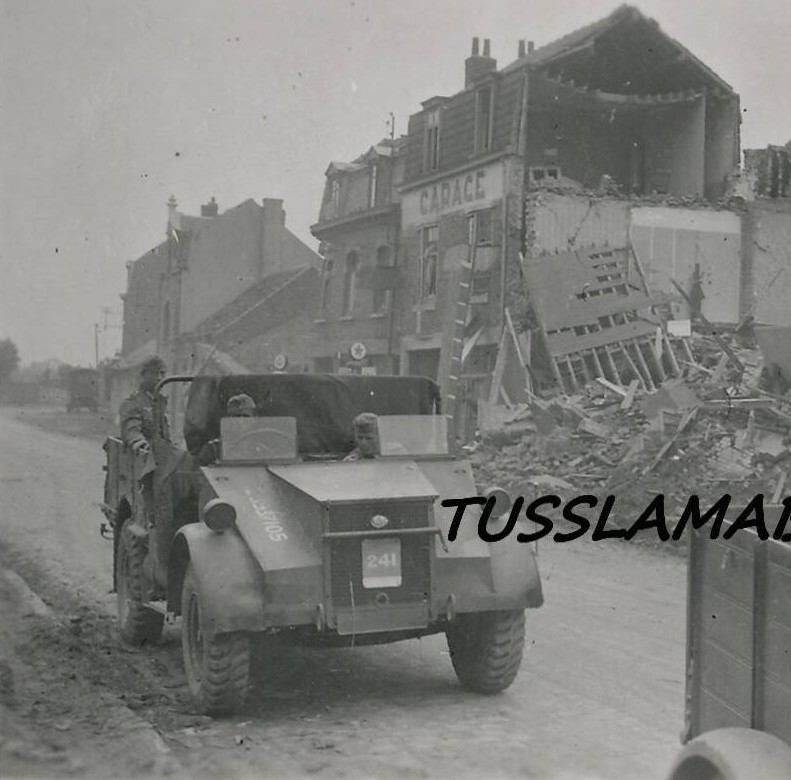
Remarkable is that used front truck is a former British army Guy Ant 4x4. These were left in Dunkerque in 1940 by the hundreds if not thousands and on such same vehicle the journey to France is made back nine years later...
Photo right: the Germans recovered Guy-Ants from Dunkirk and re-used them in their own army.
Whether B-34774 is purchased by the Wagenaar family from German or British army-surplus is not known.
The army Chevrolet probably stayed on the island. It was painted blue and got a job at the lifeboat station.
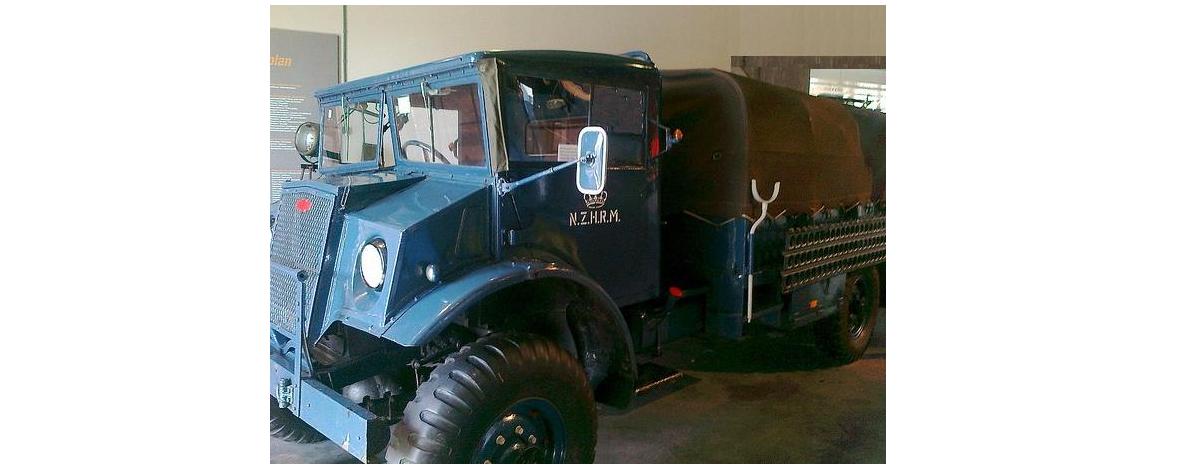
© ZZairwar. Zuyder Zee Air War. 30 May 2021.
Sources;
- ZZairwar research files on Kapelle and Jonkerbos Nijmegen 2011.
- ZZairwar photo collection
- Site Polish war graves (in English)
- Historical Society Ameland
- Amelander Musea - Ameland
- Site CWGC
- Site ABMC
- Bevrijdingsmuseum Zeeland